
At first glance, the headline news here is that COROS has finally announced an AMOLED watch. But, I actually don’t think that’s the most interesting piece here.
Instead, it’s the fact that for the first time in its history, COROS is trying to compete directly price-wise, with their competitors. Typically speaking, COROS will undercut its competitors (such as with the COROS Pace 1/2/3 & Dura). Or, they’ll completely miss on pricing, and rely on hopes and dreams to sell products (such as the APEX Pro 2 series, which eventually had to adjust pricing downwards).
But the Pace Pro, priced at $349/399EUR is the closest the company has ever come to matching their competitors on features and pricing. The question is, does the company pull it off? While simply changing the display type to AMOLED might sound like an easy thing, many companies, including Suunto & Polar, took months (or more) after release to finesse the details. Just slapping an AMOLED screen on an existing MIP-based watch results in a poor experience, especially with nighttime viewing. Plus, it can result in horrific battery run times. COROS is aiming to avoid that first-timer experience with the Pace Pro, so, let’s see how well it works.
COROS sent over a couple of media loaners to test out. As usual, this review is not sponsored (nor does any company get to preview anything I review), and I don’t take any advertiser money from any companies I review. Once this unit goes back, I’ll go out and buy my own for any future testing needs. If you found this review useful, you can use the links at the bottom, or consider becoming a DCR Supporter, which makes the site ad-free, while also getting access to a behind-the-scenes video series. And, of course, it makes you awesome.
What’s New/Different:
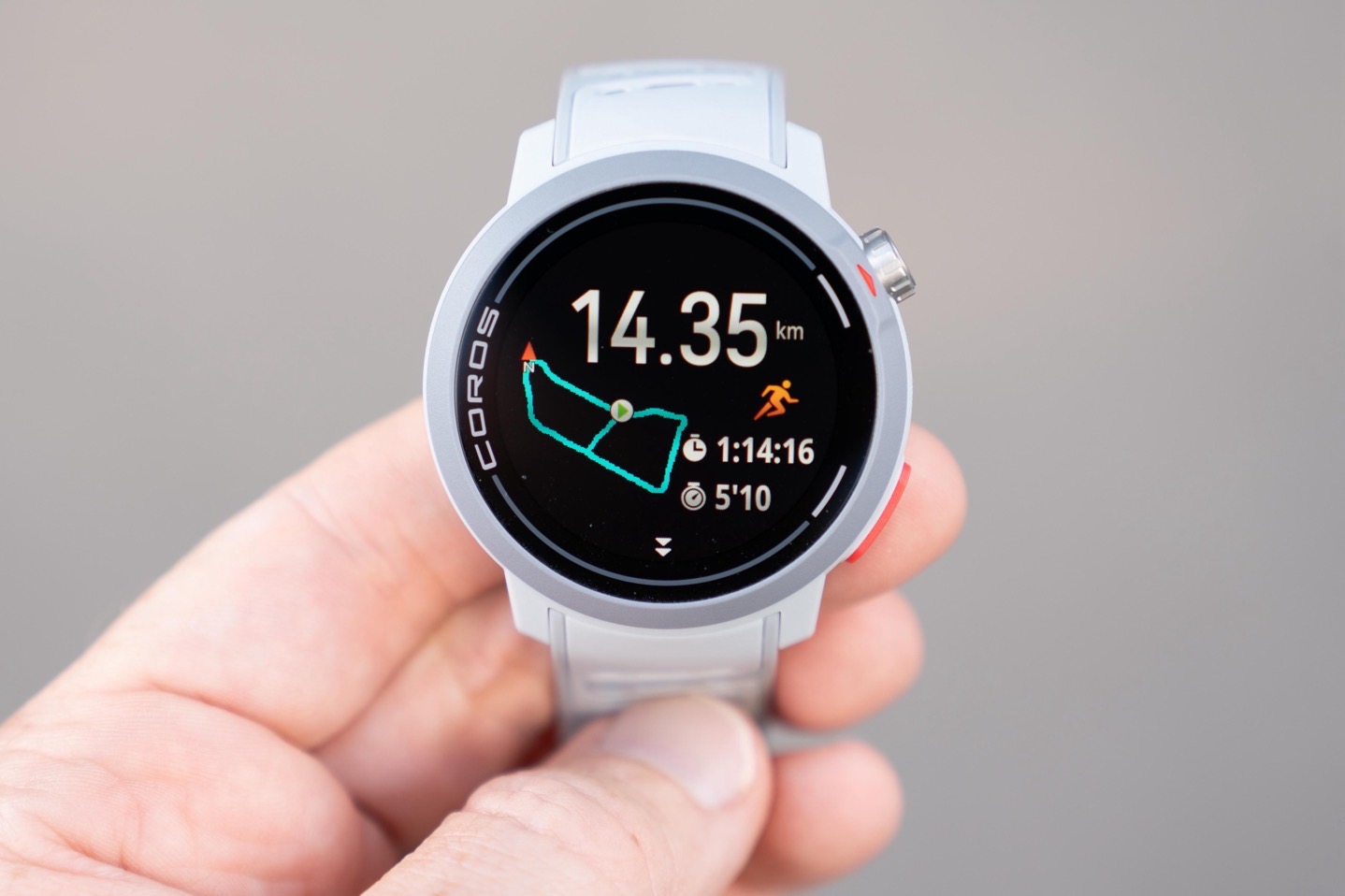
The COROS Pace Pro is kinda a Pace 3, but also kinda not. Yes, it’s easiest to mentally think of it as a Pace 3, but technologically speaking…nah. After all, it’s got a new processor, new heart rate sensor, new GPS chipset, new display, new battery, new button sizing, new GPS antenna, new band design, new…well…basically everything. Including, most notably, a price nearly double that of the Pace 3. In fact, one could basically argue this is actually more of an Apex 3 than anything else. Nonetheless, we’ll continue pretending it’s a Pace 3+.
Here’s how it differs from the Pace 3:
– Switched from MIP to AMOLED display (from 240x240px to 416x416px)
– Increased display size from 1.2” to 1.3” (still mineral glass)
– Increased case size from 42mm to 46mm
– Increased button sizes and grip substantially
– AMOLED Display brightness is 1,500 nits
– New optical heart rate sensor (versus Pace 3)
– Added ECG feature (Note: Not FDA/CE certified, no AFib detection)
– New GPS chipset & antenna design (versus Pace 3)
– Increased GPS battery life from 25hrs to 38hrs (‘All Systems’ mode, full chart below)
– Daily smartwatch battery life 20 days (gesture display) or 6 days (always-on display)
– Switched from included fabric band to included silicon band
– Increased internal storage from 4GB to 32GB
– Increased processor speed
– Added full-color maps (details down below)
– Increased weight slightly from 39g (silicone) to 49.1g (silicone), or 30g to 37.1g (if nylon/fabric)
– Maintains 5ATM (50m) water resistance rating
– Maintains temp range of -4°F to 122°f (-20°c to 50°c)
– Price increases from $229 to $349 (though obviously, a big feature jump)
Here’s the battery life chart:
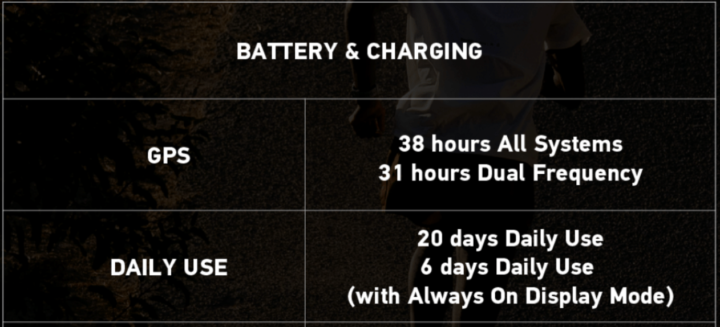
When it comes to mapping, COROS has implemented the same style of maps as found on their APEX and Vertix series watches, which I detail down below. In short, that’s background maps, but not routable maps (you can have routes/courses and turn-by-turn directions, but cannot re-route mid-course). Still, as you’ll see, it works perfectly fine in most cases. More importantly though, is that COROS has confirmed that coming in Q1 2025, the company will add street/trail names to the maps. That’s even more notable since Polar just announced last week that they will be adding POI (points of interest) data to their maps in Q1 2025. Now, if these two companies just blended their efforts, we’d have everything!
In the Box:
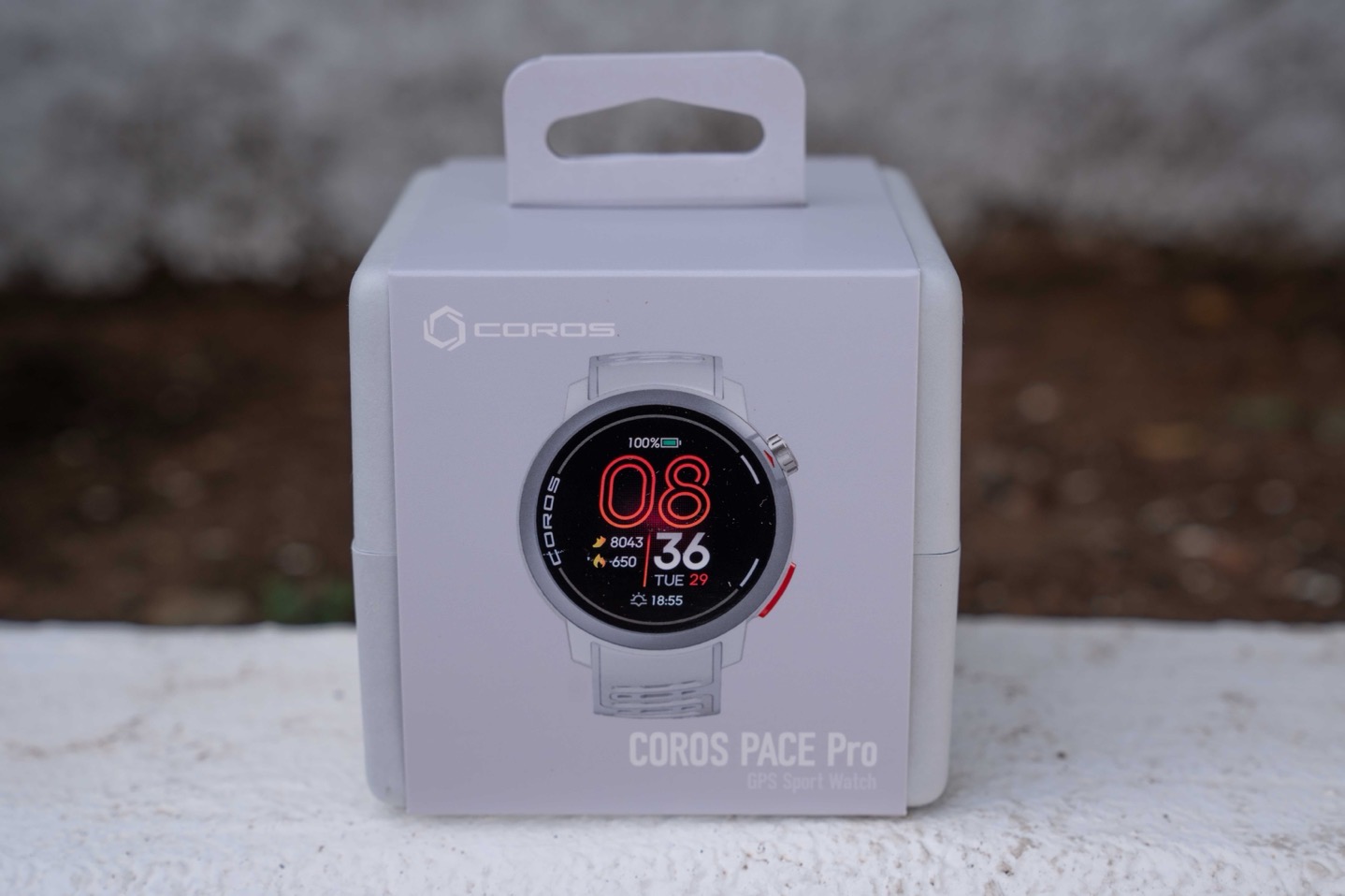
The COROS Pace Pro is very similar box-wise to other COROS products, except there are two notable differences. You’ve got the watch, a charging keyring adapter, and some paper stuff.
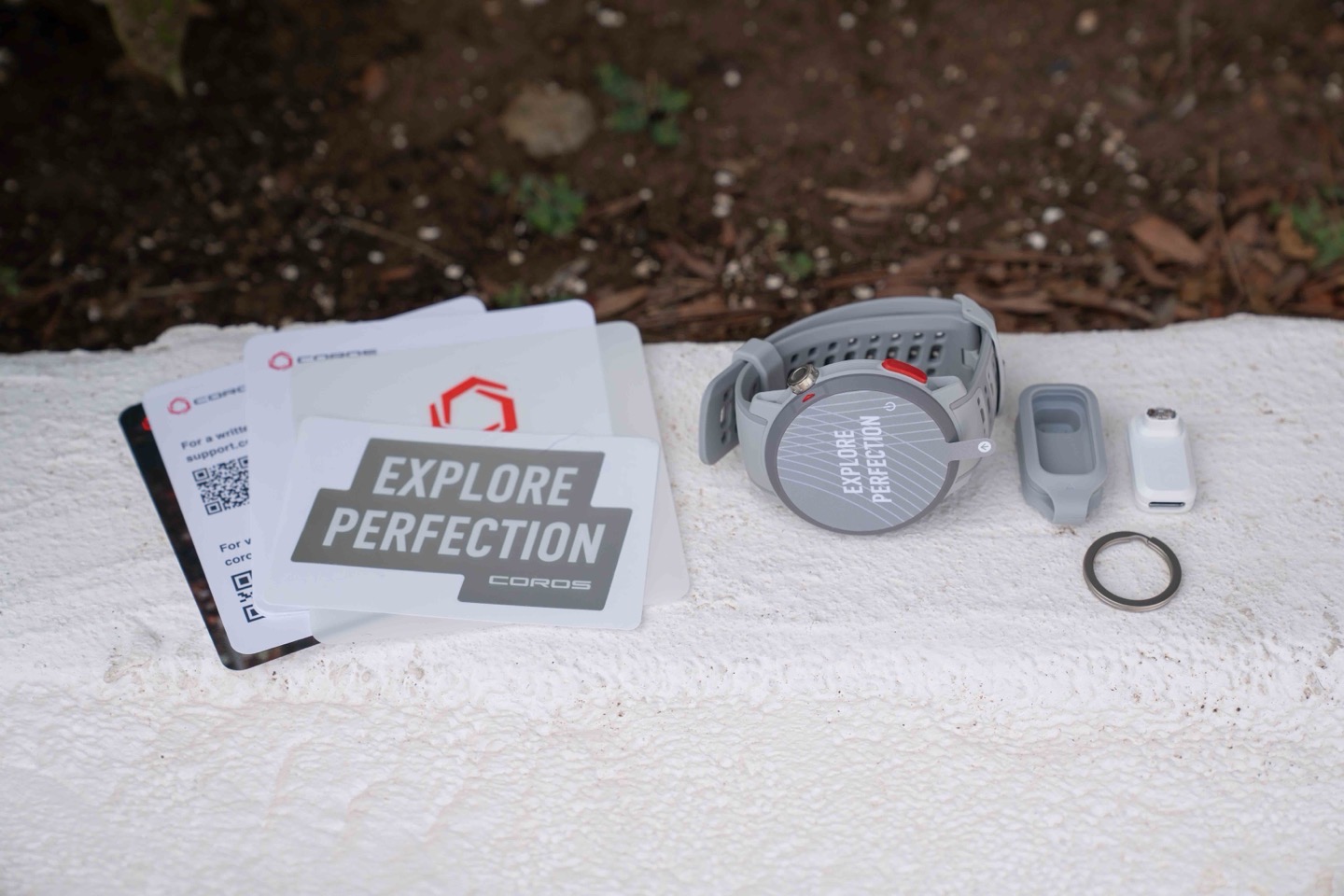
Notably first, the watch now comes with a silicone band instead of a lightweight fabric band. There are pros and cons to this. On one hand, I really liked the previous fabric band. On the other hand, the fabric band meant that after your workout/shower, the fabric was still wet, and would leave a wet spot on anything you rested your wrist on (pants, shirt, couch, crotch, etc…), for about 30 minutes post-shower/pool. The silicon band is obviously dry the instant a towel is applied to it.
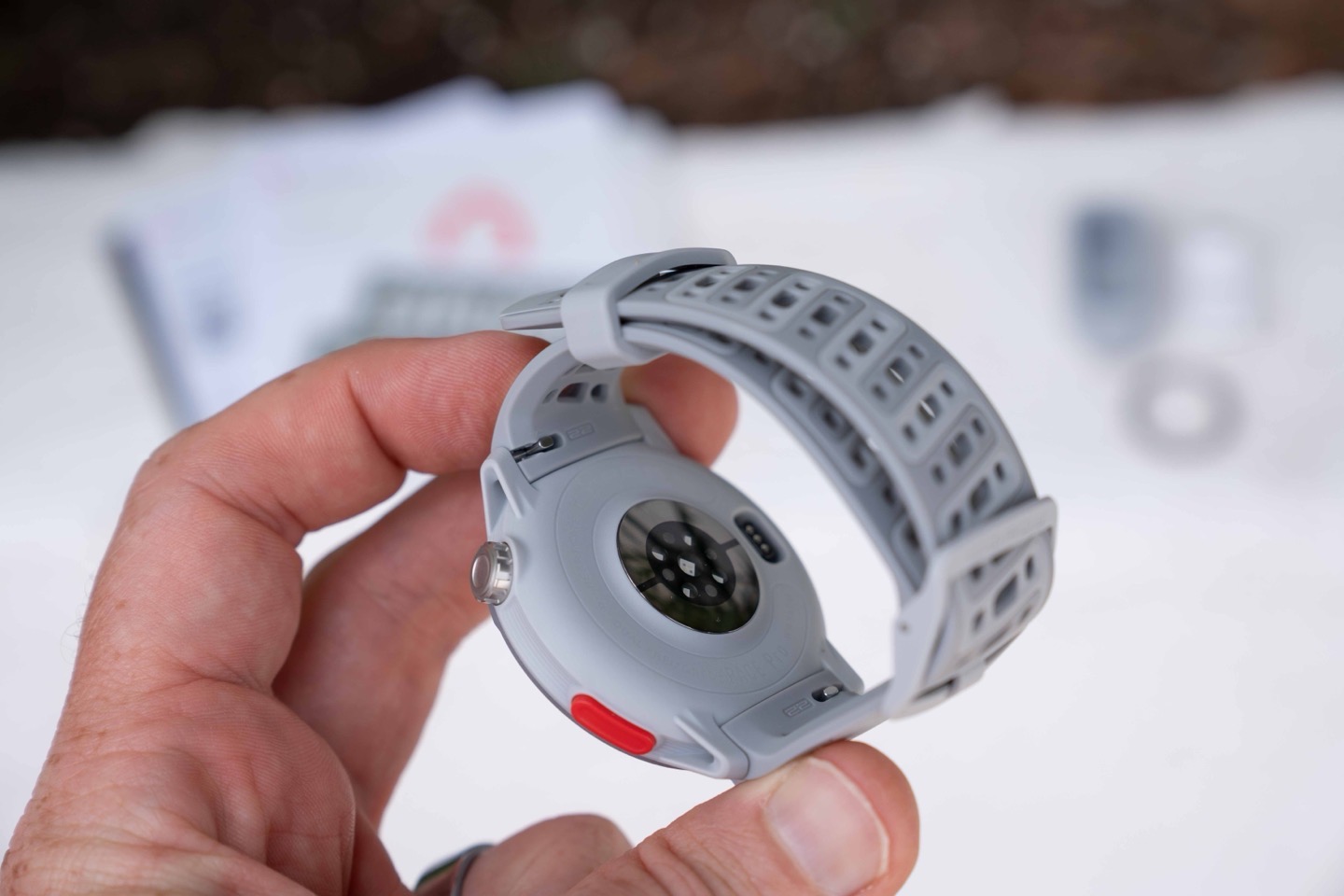
The second difference is the lack of a charging cable, and instead, a charging keyring adapter. COROS has played around with such an adapter in the past, and 3rd parties have made one for other companies, including Garmin and Apple. Essentially, you take your own USB-C cable and stick it in the end of the keyring adapter, and boom, you’ve got a charging cable. COROS says if you can’t find a USB cable of your own, what rock are you living under, they’ll happily send you one.
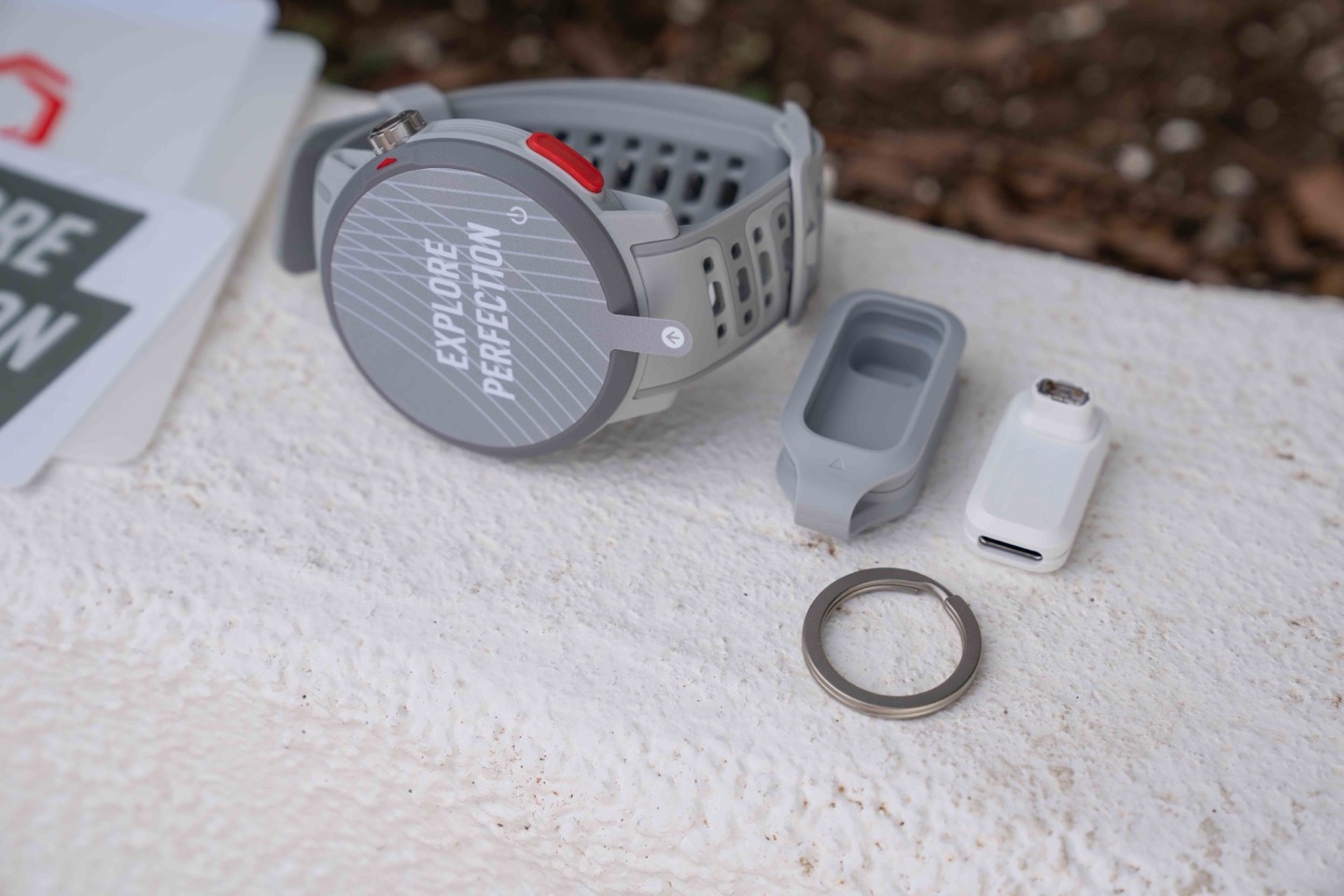
The only downside to this adapter, is COROS slightly changed it (and the charging port) from all their previous watches. It is neither forward nor backwards compatible. Specifically, the new charging port is deeper than the previous one. And likewise, the charging adapter has a slightly girthier connector, so it won’t fit older watches.
COROS says the reason they did this was they found the existing connector was prone to connection issues long-term, since it wasn’t deep enough (ironically, they noted the same thing happens on a competitor cable/port. That’s ironic, because the super-snarky me would reply, ‘Well yes, if you didn’t blindly copy Garmin’s connector in the first place, this wouldn’t have happened’…but I won’t say that…). In any case, the good news is I confirmed that if you are in a pinch at a far flung race without the new cable, you can safely take/steal an older cable from someone else, grab a butter knife from the hotel kitchen, and remove just a tiny bit of the extra rubber on the side of the cable, and it’ll fit just fine down into the deeper port on the Pace Pro. You’re welcome.
Sorry, where were we? Oh, right, stickers:
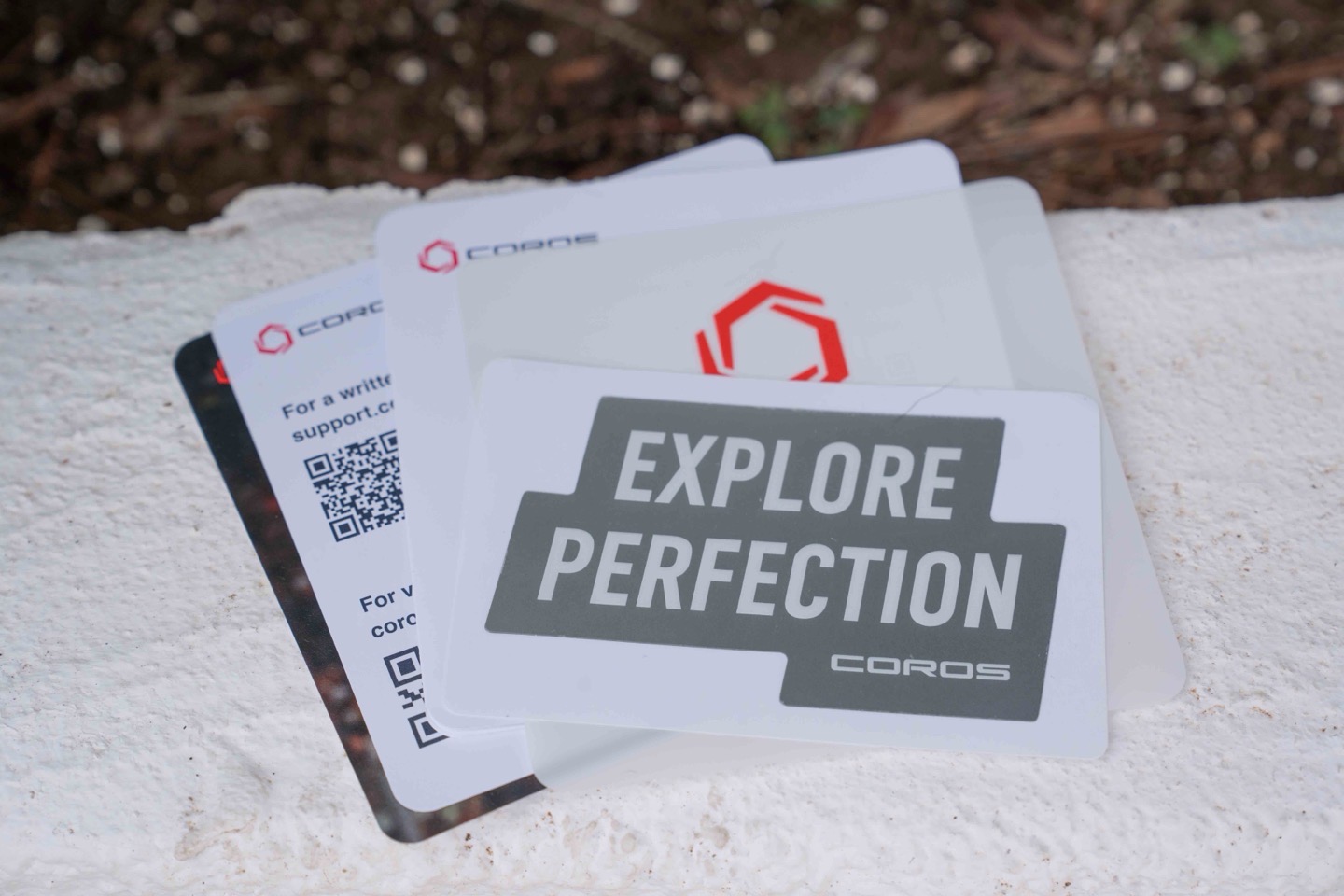
With that, let’s talk basics.
The Basics:
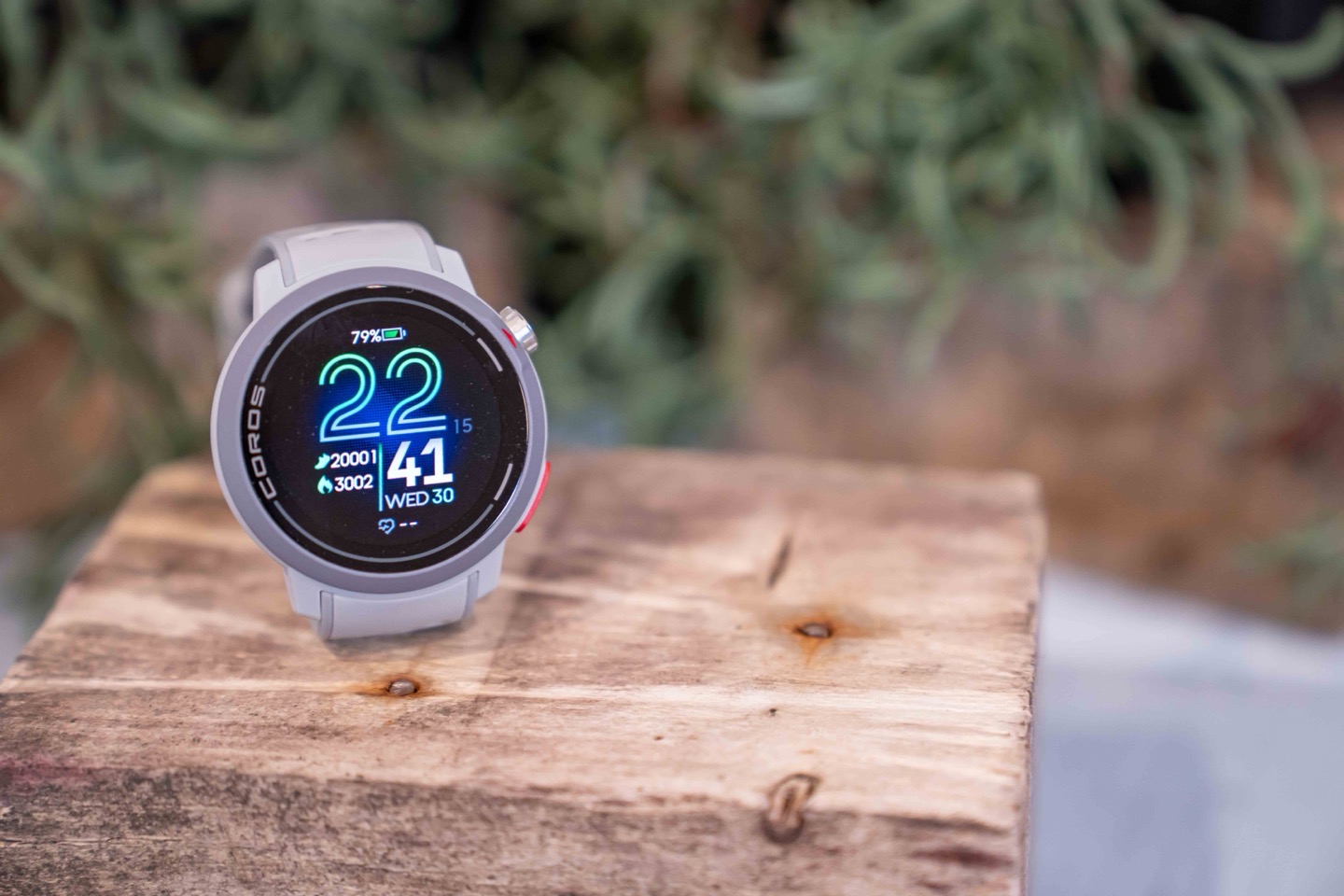
For this section, I’m going to focus on aspects like daily usage, watch basics, and everything non-sport. So stuff such as activity tracking, sleep tracking (and night usability), HRV tracking, buttons, the new AMOLED display etc…
First up, let’s get the buttons out of the way. The unit follows other COROS watches, by having a Digital Crown and a secondary deviated button (but doesn’t have a third button akin to the Vertix series):
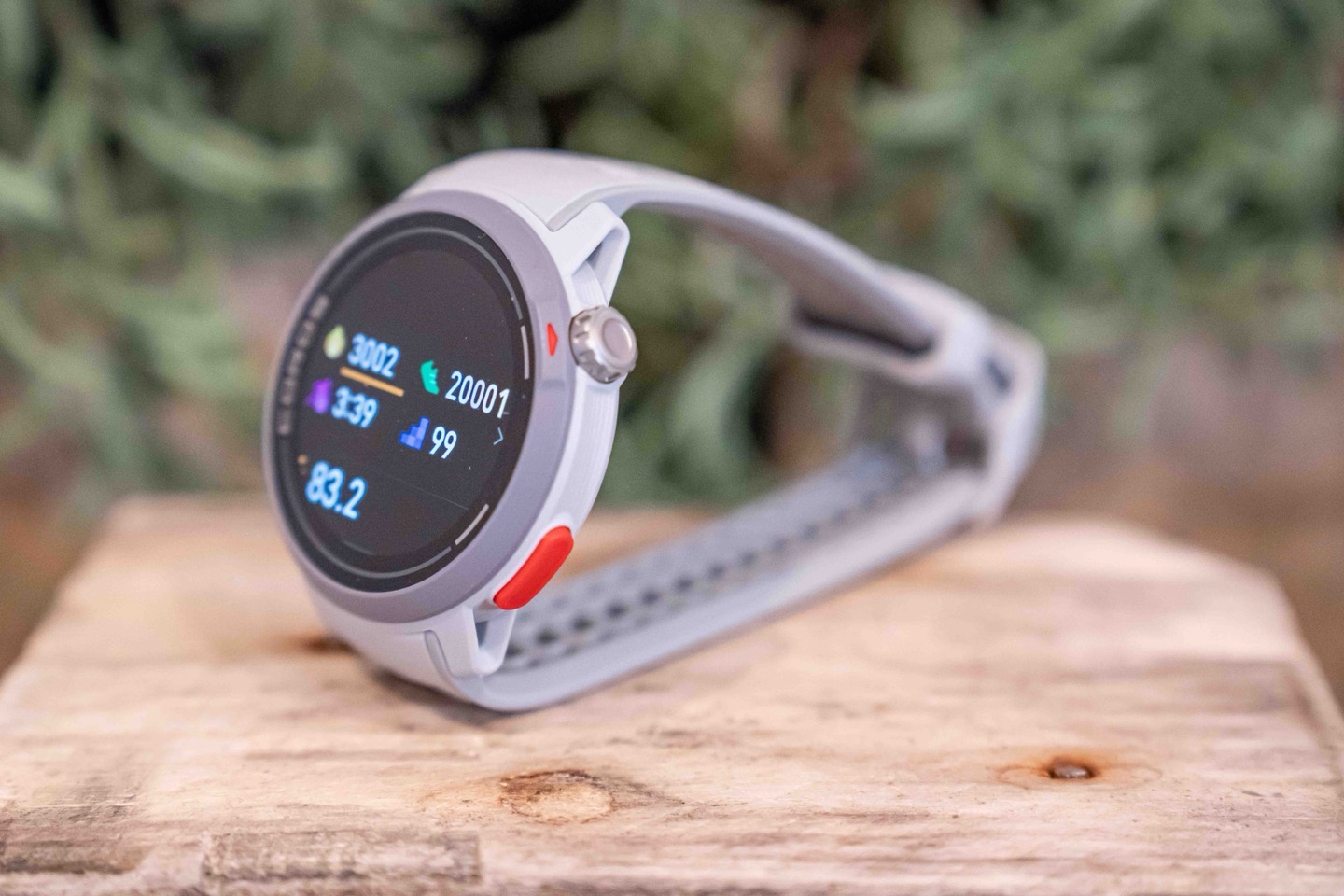
I’ve long said, whether it’s COROS or Apple, I don’t find the Digital Crown all that awesome on a watch (or a bike computer). But I recognize some people like it, it’s just not my thing. I will admit it works well for maps (zooming in/out), but for everything else I’d rather just have buttons.
In any case, moving along to the big-ticket item – the new AMOLED display. The COROS Pace Pro sports a 1,500 nit display, which is plenty enough for both night-time visibility as well as sunny beach visibility (given I now live in the middle of the Mediterranean Sea, I can validate this works perfectly fine on the brightest of days).
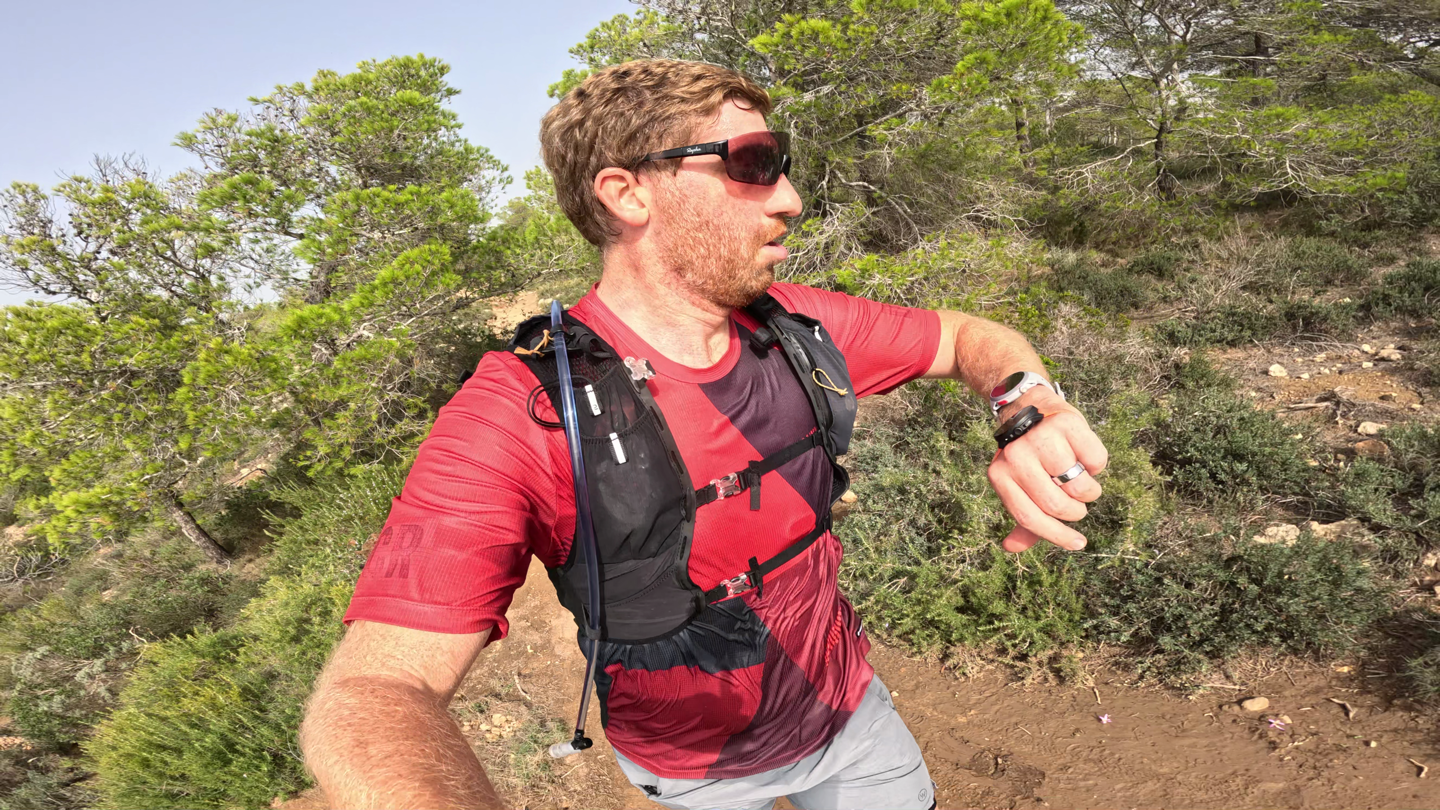
Like all AMOLED displays, you’ve basically got two ways the display can be configured. The default is called ‘Gesture Based’, which means the display turns off when you’re not looking at it, and then instantly turns back on when you raise your wrist. However, my preference is ‘Always-on’ mode, which obviously takes a battery life hit (down to 6 days in smartwatch mode), but means the display is in a dimmed state normally, but goes to full brightness when you raise your wrist. Thus, even as I type this, you can see the time just fine in the dimmed state:

And then, when I rotate my wrist, it goes to full brightness:
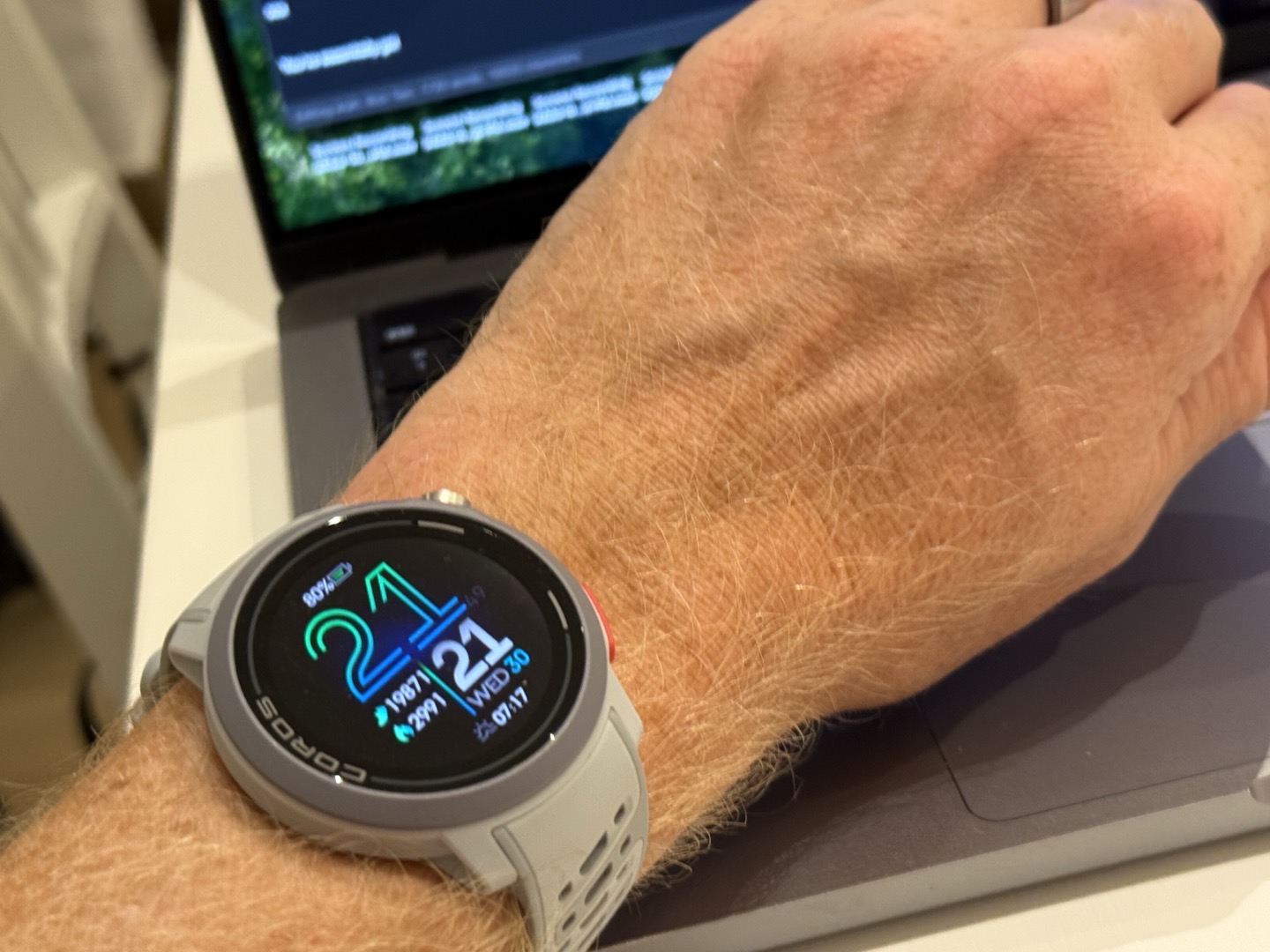
As noted, COROS claims 6 days in always-on mode. My testing has had 1-3hrs a day of GPS workouts, and thus, I’m finding it much closer to 4 days. This is my standard way of validating this across all watches. Most other companies that claim this 6 days (e.g. the Garmin Fenix 8), do manage to hit the 6 days with my 1-3hrs of GPS time per day. That said, I’m probably an outlier in how much GPS time I’m doing daily compared to most people. I’ll cover GPS battery burn down below.
Now, at night, the watch automatically turns on a sleep mode (based on your configured sleep times), which greatly reduces the backlight to a non-annoying level. It doesn’t blind you or light up your pillow/sheets. It’s just barely visible. It’s perfect. Though, as of this writing I can’t get back to sleep mode if I unlock the watch. COROS says a fix is coming tomorrow or the next day, which should resolve that.
However, my singular complaint is that COROS doesn’t have a flashlight mode, thus, you can’t leverage the ultra-bright display as a flashlight like you can on Apple/Polar/Suunto/Garmin/etc… COROS says that’s on the bucket list, but there’s no specific timeline for it.
Ok, let’s get into some of the general data bits. First up, is the watch face. You can choose from a couple different watch faces, but I think the default one is actually pretty solid:
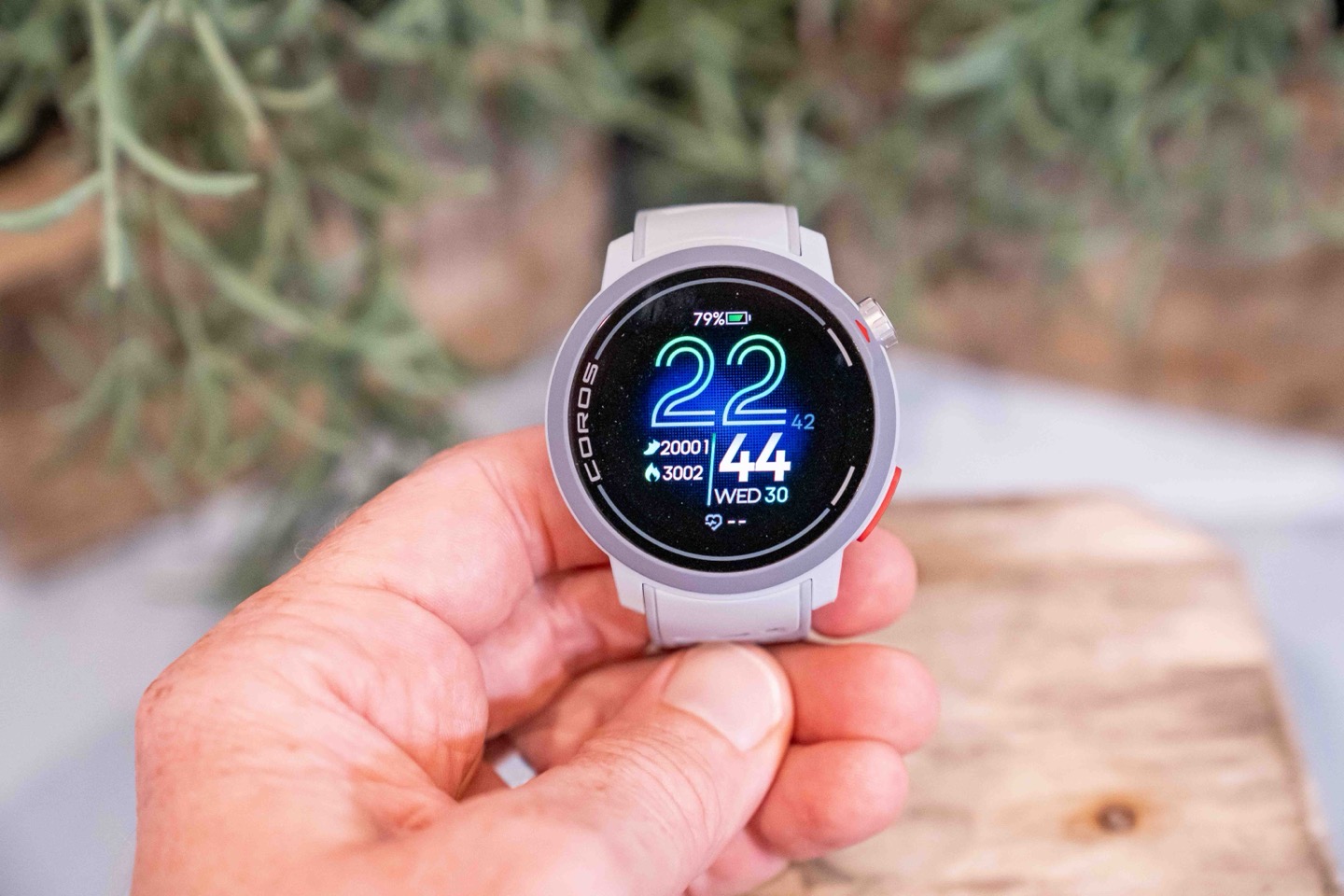
From there you can scroll down into the widgets, where you’ll find some daily stats first, summarizing your calories, steps, workout time, and blueish blocks:
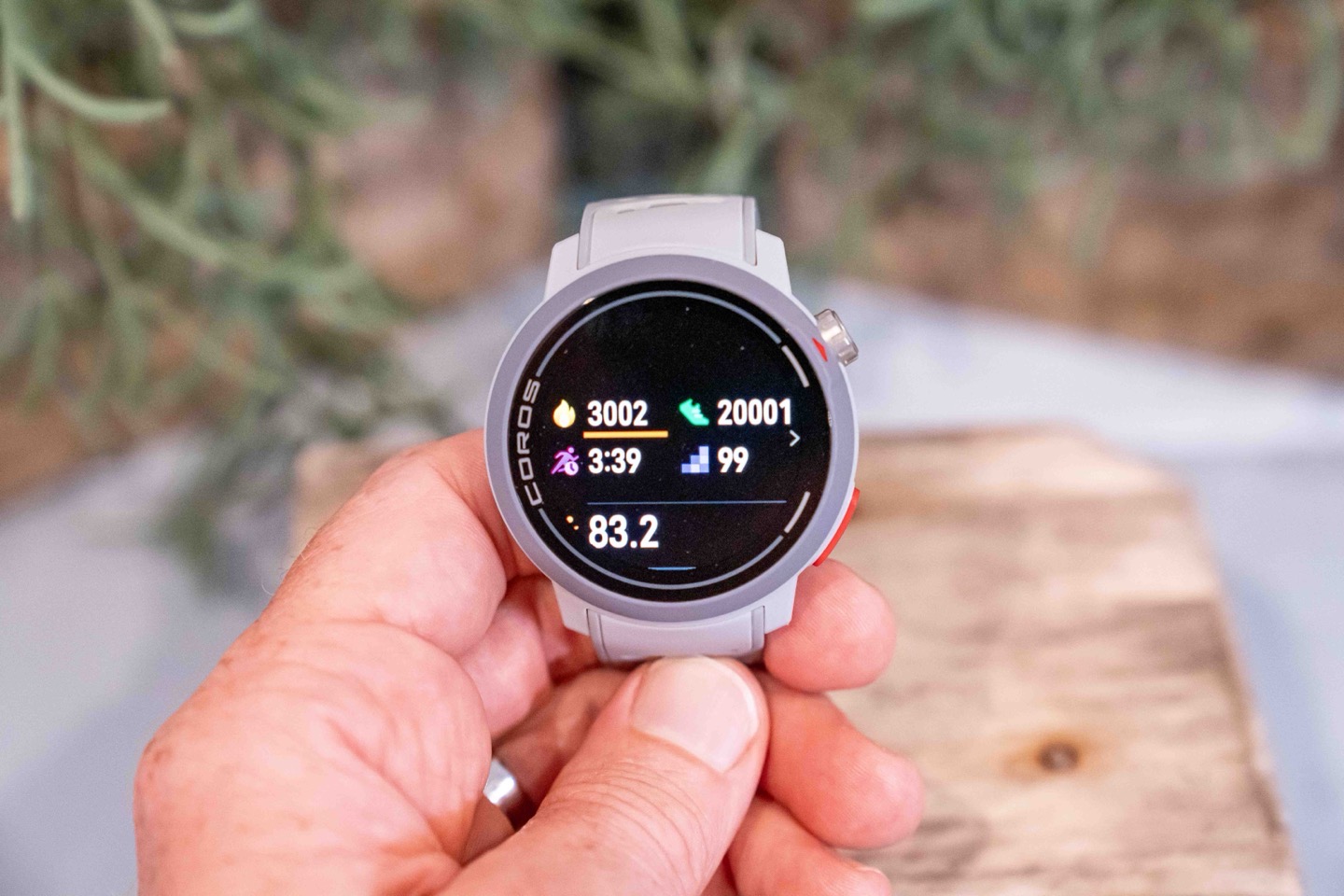
You can tap into this to see more details about the previous 7 days, such as these:

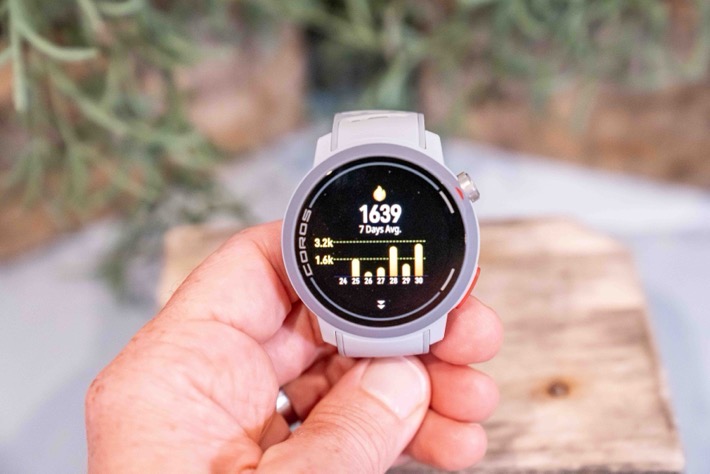
After that you’ve got a bunch of training load and performance stats. This includes your running fitness score (and race predictor times), as well as intensity trends, and recovery times.
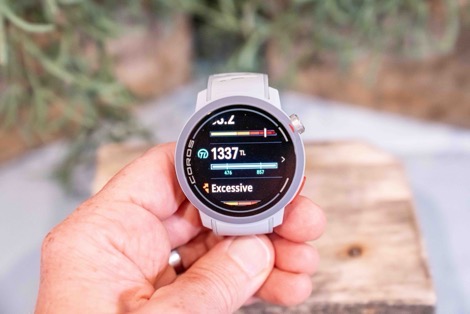
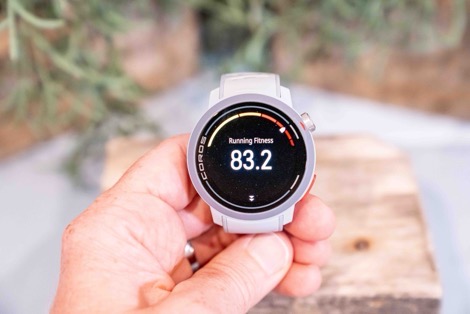
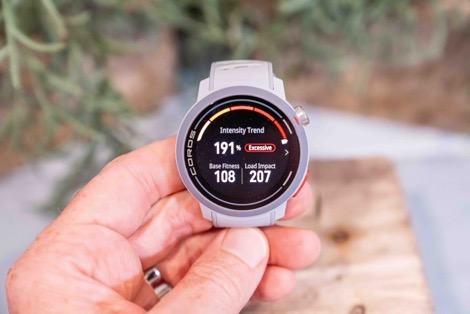
I’d repeat my usual complaint here with COROS’s display of Training Load, which is that your training load resets every Monday morning, providing absolutely zero useful information about your actual training load. Other companies show a 7-day trending value, which lets you actually figure out training load. One of these days they’ll change this:
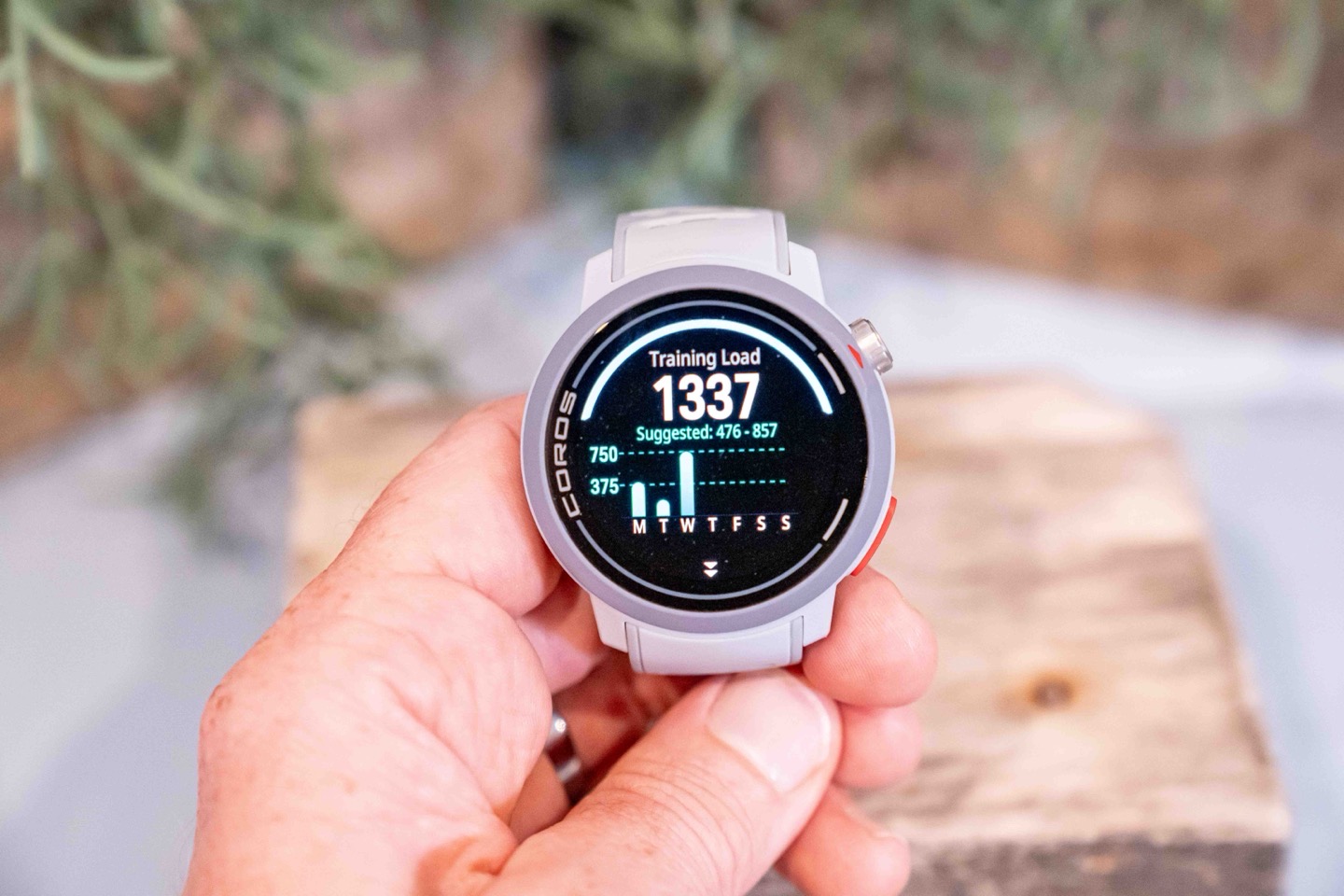
After that you’ve got heart rate and stress, and you can scroll over the timeline to see both your heart rate values throughout the day, as well as stress values. Of course, anytime you’re working out it’ll show you highly stressed, regardless of how enjoyable that time is (other companies zero out the stress values during workouts).
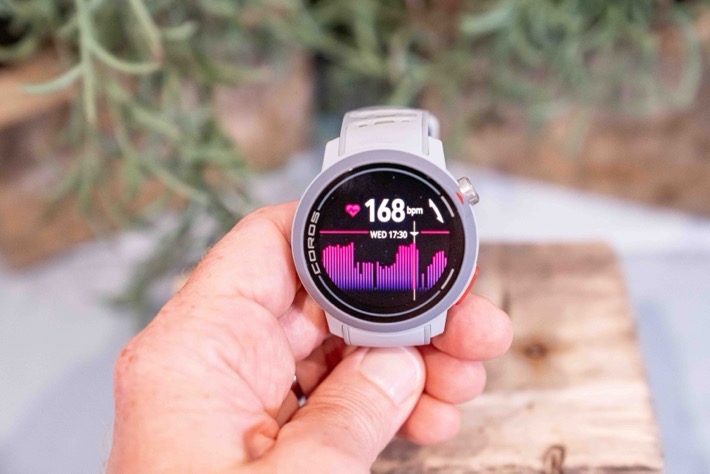
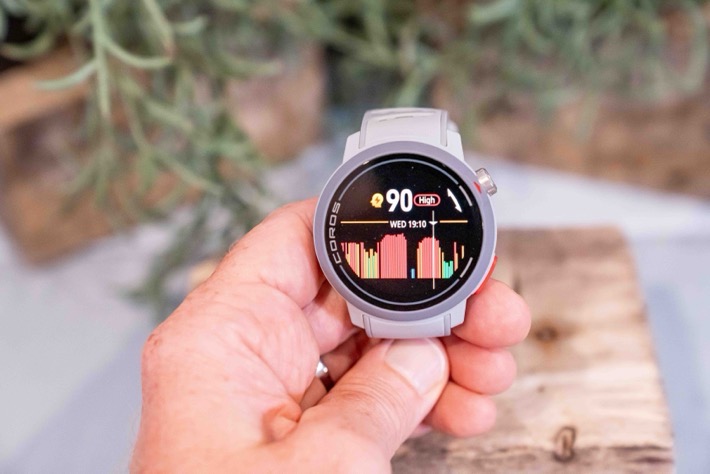
Then we get into various sleep metrics, including HRV and sleep data. Start with sleep data first, you can see your nightly stats automatically, and all of these fall-asleep/wake-up times have been spot-on for me.
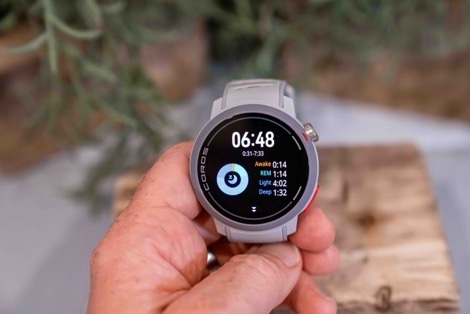
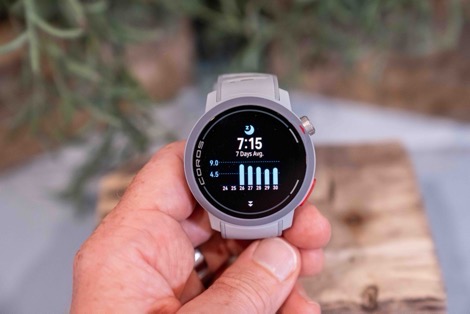
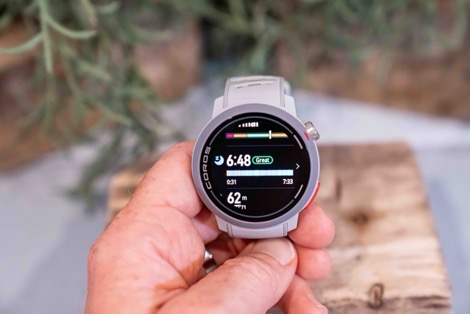
That said, I don’t do any sort of data analysis on sleep stages/phases, because even the most high-end comparative data devices are only about 80-85% accurate (and we’d never judge HR sensors based on that). Given COROS doesn’t really do much else with the sleep phase/stage data, we don’t really need to worry about it.
Then there’s the HRV (Heart Rate Variability) data. HRV is a fairly useful metric to roughly see how you’re recovering as well as handling overall daily stress (or sleep). That said, as with all companies, keep in mind that HRV is heavily influenced by other factors too – including alcohol, drugs (good or otherwise), sleep, jetlag, stress, longer/harder workouts, etc… Point being HRV is useful, but *you* need to know/identify *why* it increased or decreased. If you drank 2 glasses of wine right before bed, then it’s likely going to decrease your HRV (in a negative way).
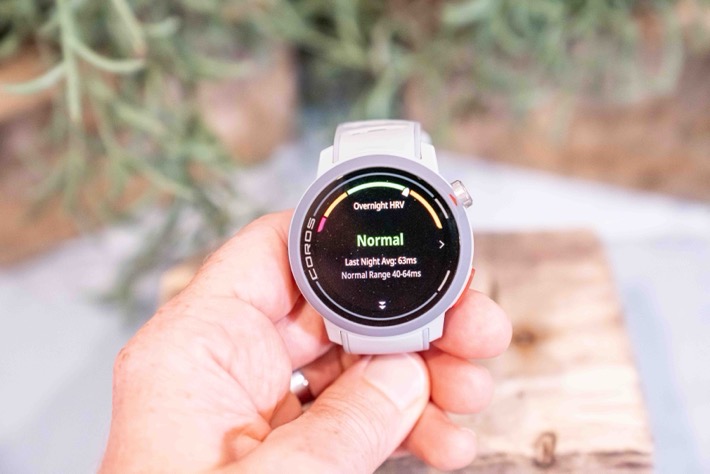
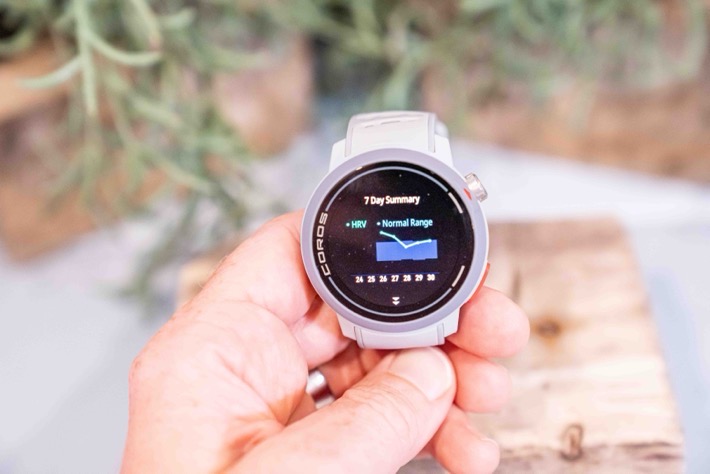
Still, the numbers I see here have been consistent with other companies’ data. Here’s data from last night, for funsies:
COROS Pace Pro: 63ms
Oura Ring V4: 67ms
Whoop 4: 62ms
Of course, all of this data is coming from the updated optical heart rate sensor, which we saw introduced in the COROS Vertix 2S this past spring, here’s the back of the Pace Pro:
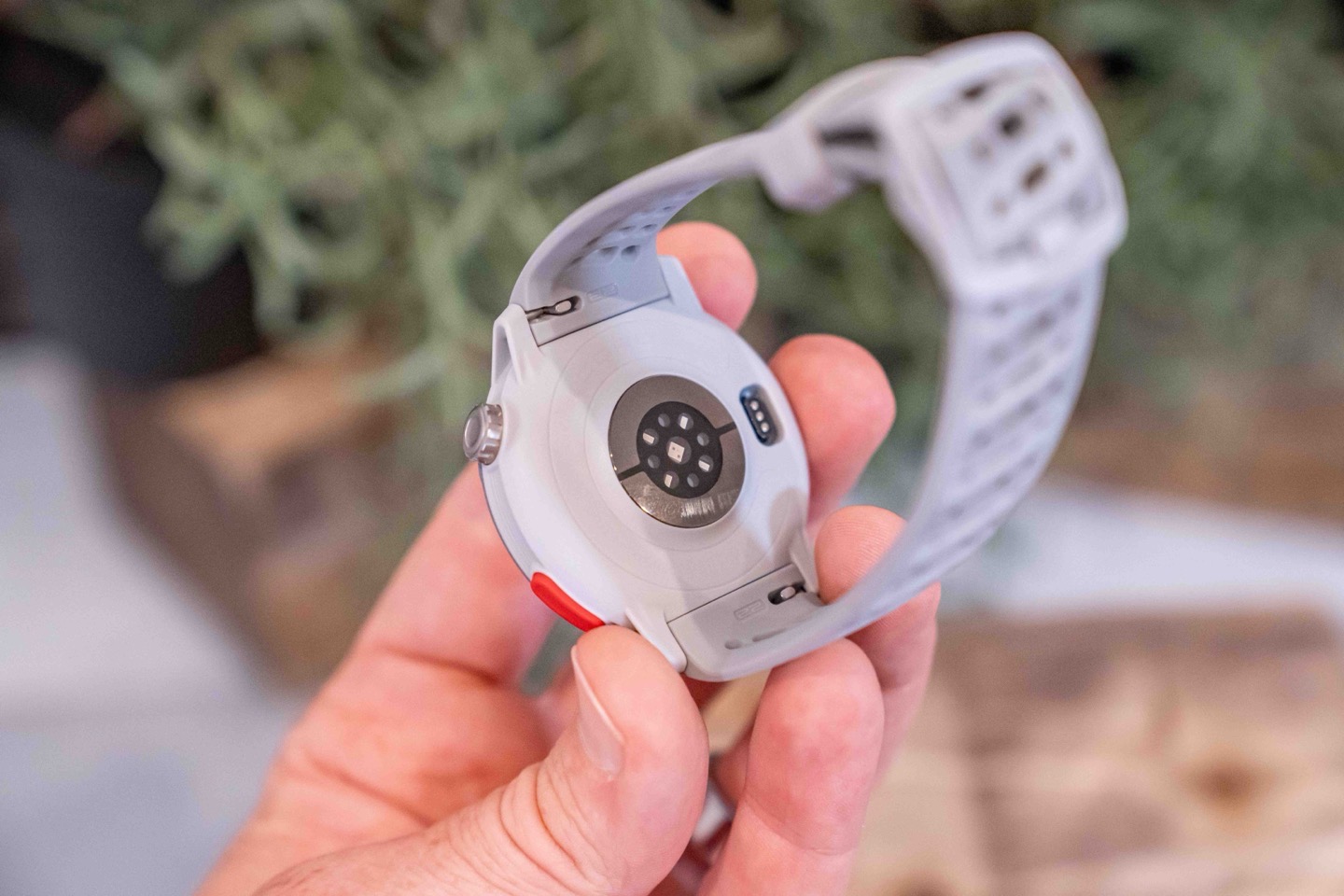
I’ll dive into accuracy during sport later in this review. Also note that COROS has an ECG mode, but that mode won’t identify AFib conditions, nor is it certified by the FDA or CE (EU). As such, don’t use it as a medical device, but rather, just a fun way to watch an ECG plot go up and down in real-time.
Finally, after that we’ve got some general metrics around elevation, sunrise/sunset, barometric pressure, weather, and text messages.
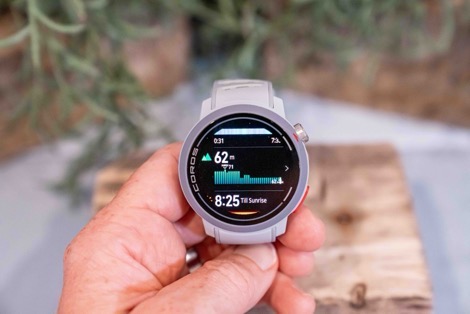
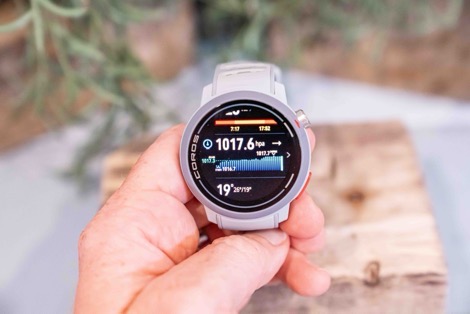
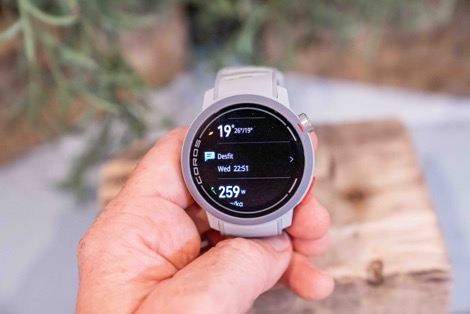
When it comes to text messages, you can view basic text details, but there’s much room for improvement here. For example, emojis don’t come through. While other aspects like photos in texts are limited by Apple (in the case of an iPhone), COROS could add photos in texts on Android. Here’s a text message comparison between a Forerunner 265 and COROS Pace Pro (Des’s emojis simply vanish altogether, leaving an empty message).
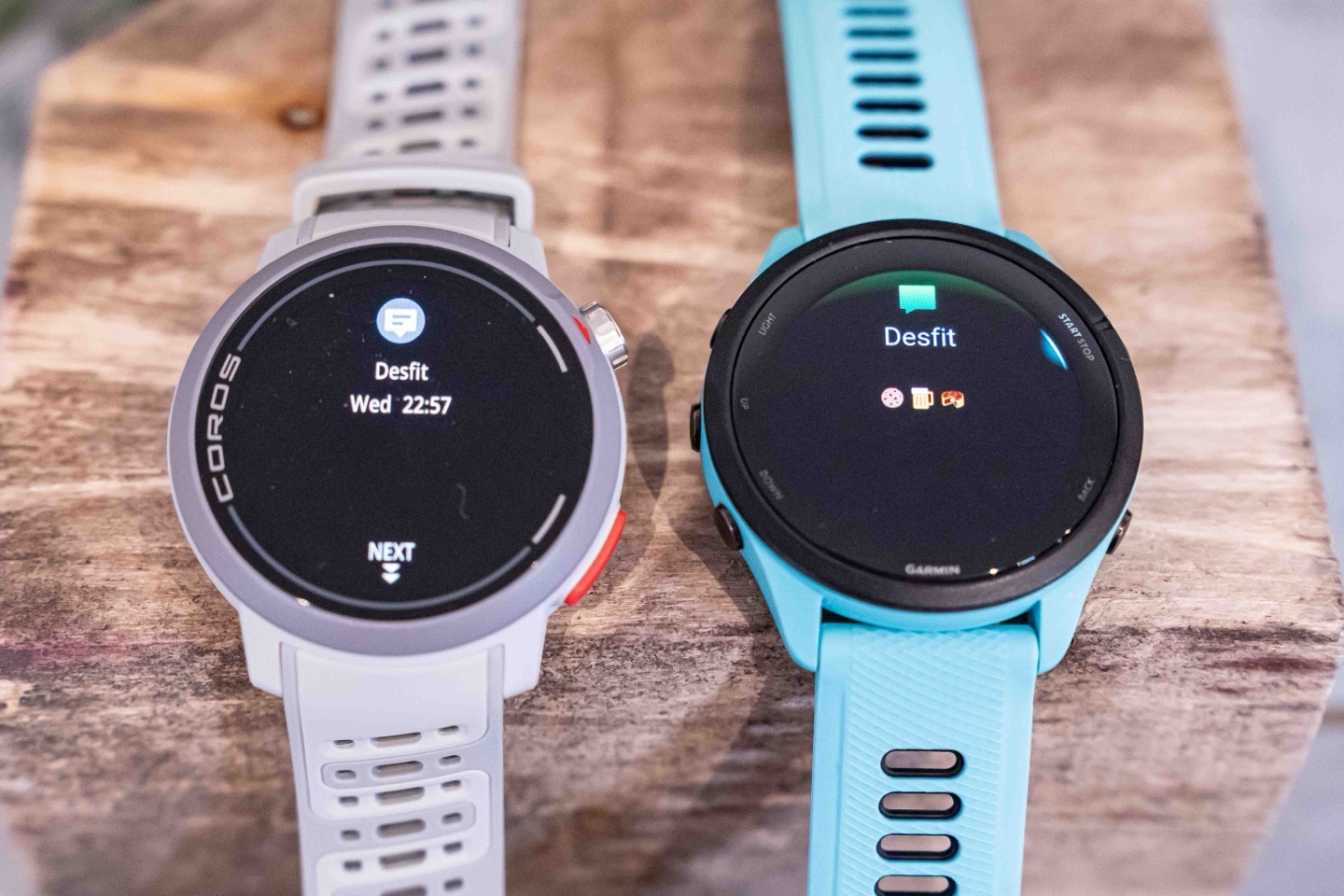
In some ways, for the endurance sports watch companies (not on Apple Watch or WearOS), I find text messages one of the most uniquely accurate ways of acting as a barometer for the overall smarts of a watch. In this case, COROS could do well to spend some time adding emoji support to take advantage of that display.
Oh, and one last thing is music support. While you can load music onto the device’s 32GB of internal storage, and play that back via headphones, more than likely you won’t. The only music supported is MP3 files that you own. There’s no support for any streaming services (or podcasts), and realistically speaking, streaming services (e.g., Spotify or YouTube Music) just aren’t going to happen for COROS.
Those castle gates closed years ago, and are barely even accessible for the biggest of smartwatch companies shipping millions upon millions of units a year. That said, I feel like COROS could try and bridge the gap a bit on things like podcasts, which are totally within their control/realm of possibility.
With that, let’s talk about what you actually bought this watch for: Sports.
Sports Features:
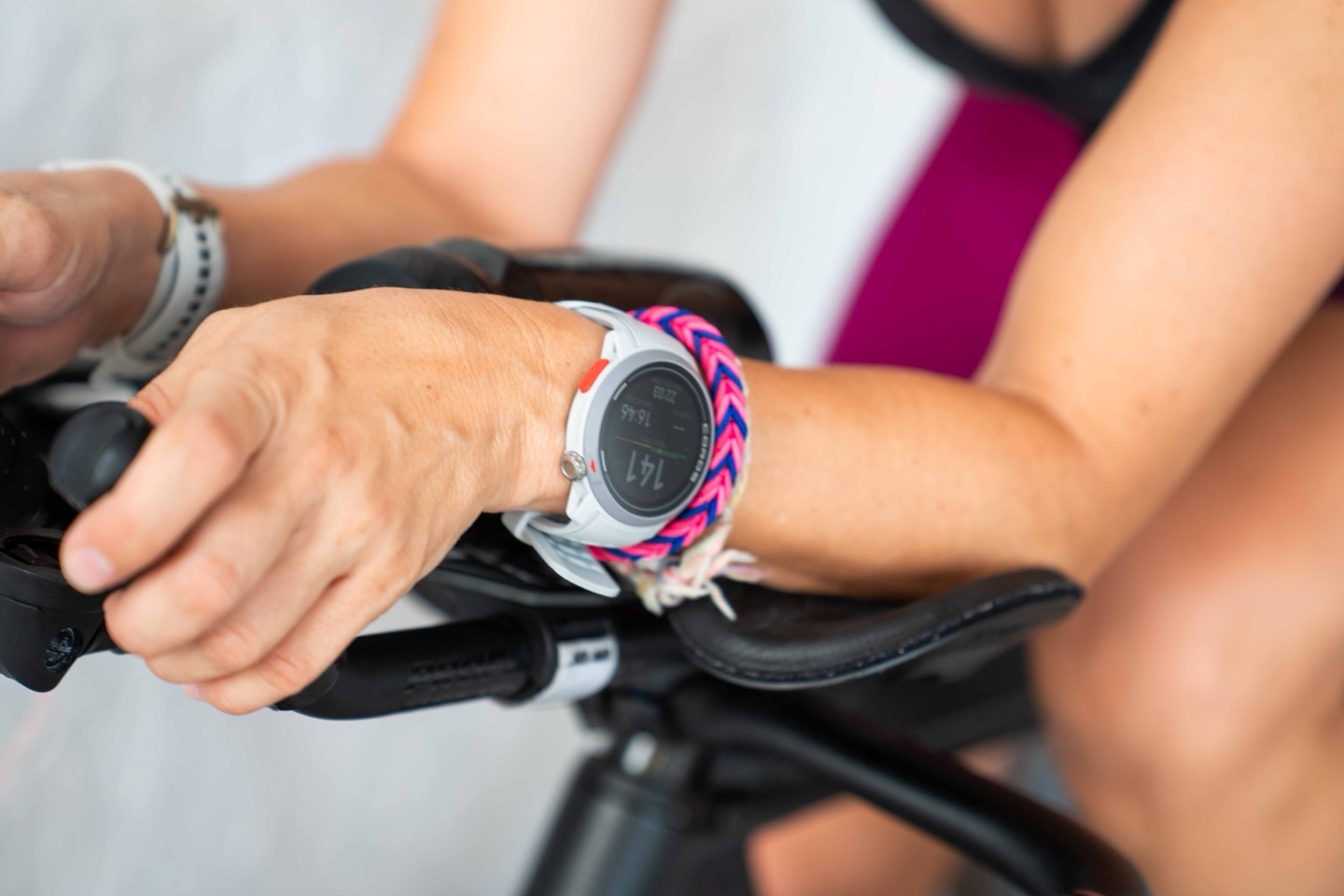
The COROS Pace Pro has pretty much all the sports profiles you’re likely to use, with COROS only saving a handful of sports profiles for their higher-end watches, such as various climbing (like rock climbing) modes in their APEX and Vertix series. With the sizing being pretty reasonable at 46mm, it’ll work for both small wrists (like my wife’s above), or my larger wrists.
To begin, you’ll tap the upper right button to see the lists of sport profiles, and then select a profile of your choice. You can also select structured workouts and Training Plan details from this menu, as well as Fitness Tests.
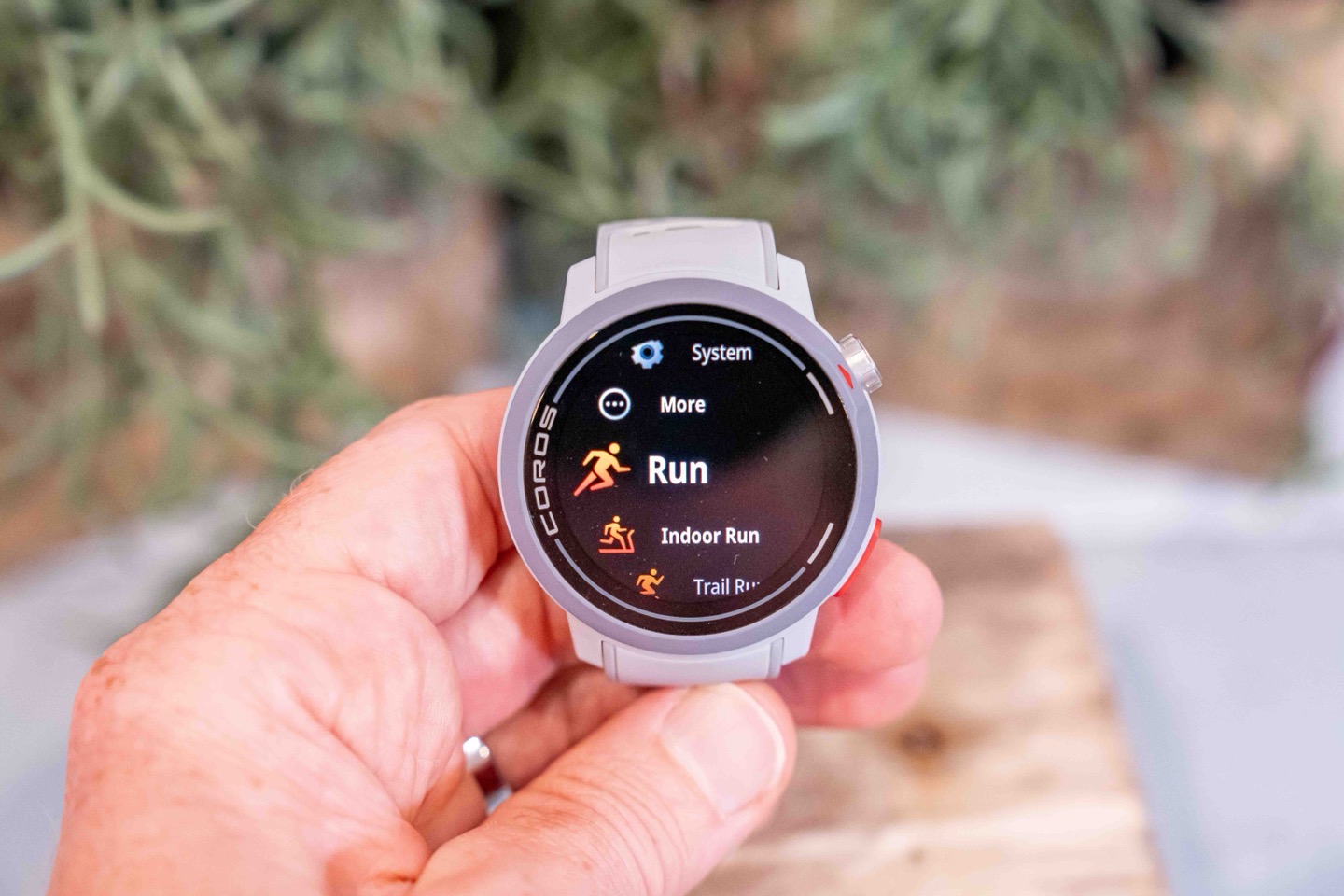
Once you’ve selected a sport profile, it’ll start locking your heart rate and finding GPS (if outdoors). Additionally, if you’ve got sensors paired, such as a heart rate sensor or cycling sensor/power meter, it’ll go and connect to those. Likewise, you can enable various pacing features and alerts (depending on the sport).
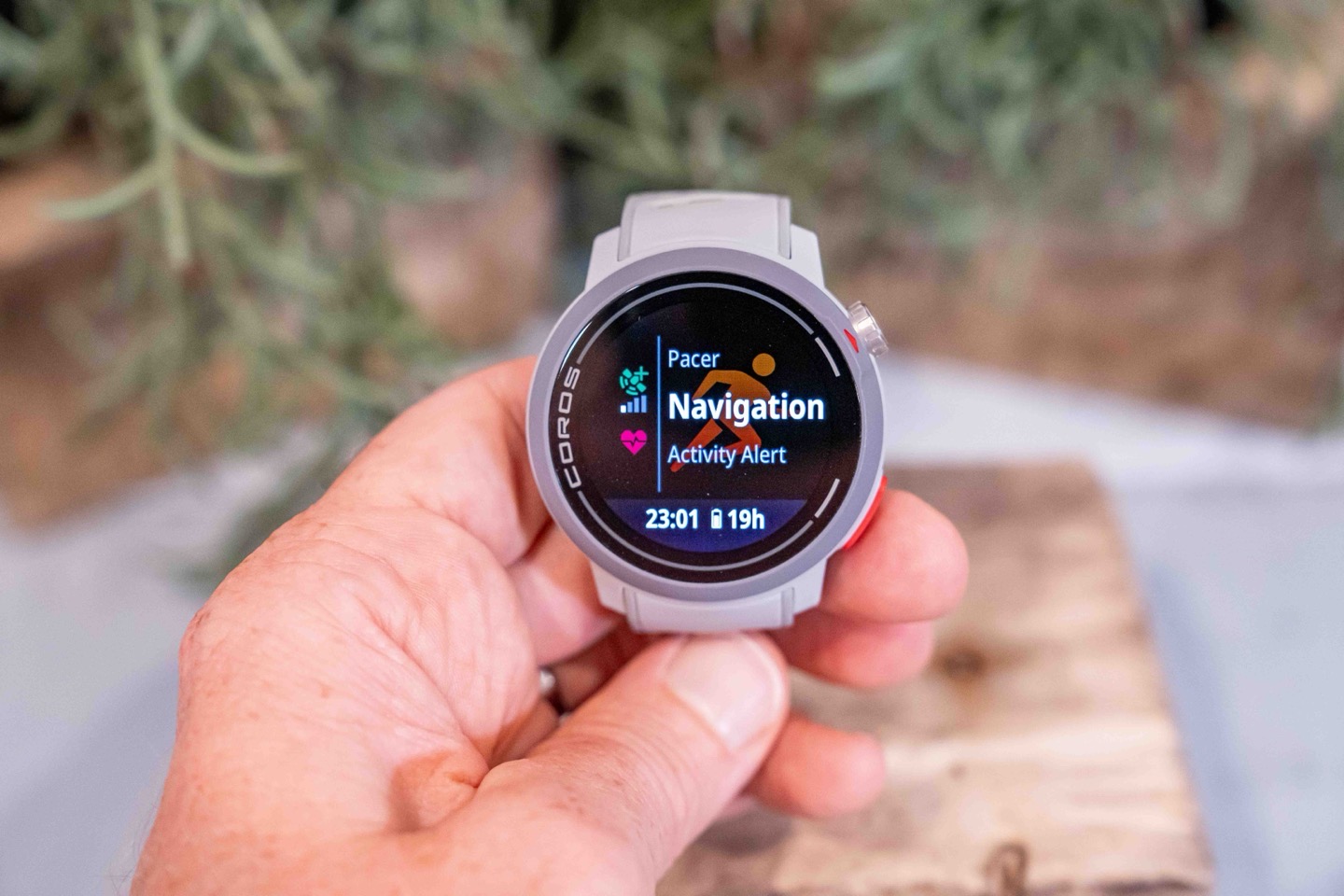
You can also select a course other than navigate, but I cover that down below in the ‘Mapping & Navigation’ section.
When it comes to data page/field configuration, that’ll all happen within the COROS smartphone app, which lets you configure data pages/fields as you see fit, including some pages that are graphs, like elevation:
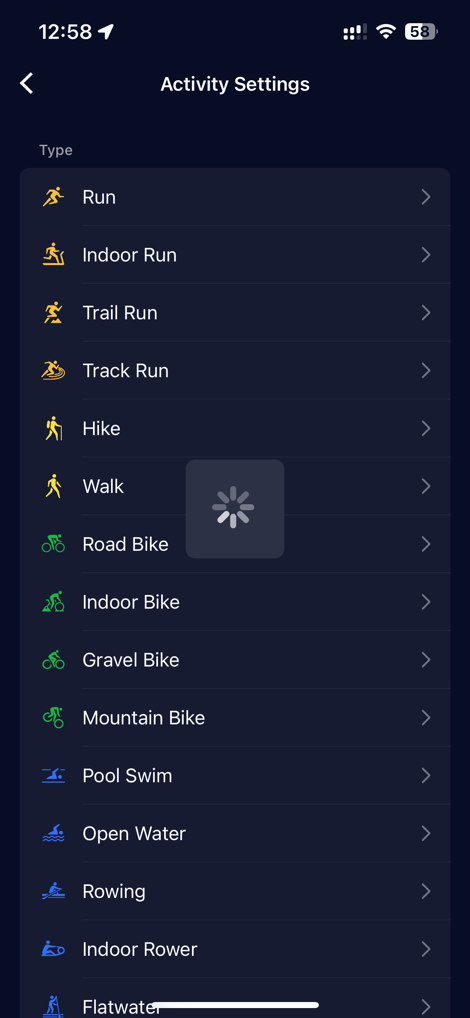
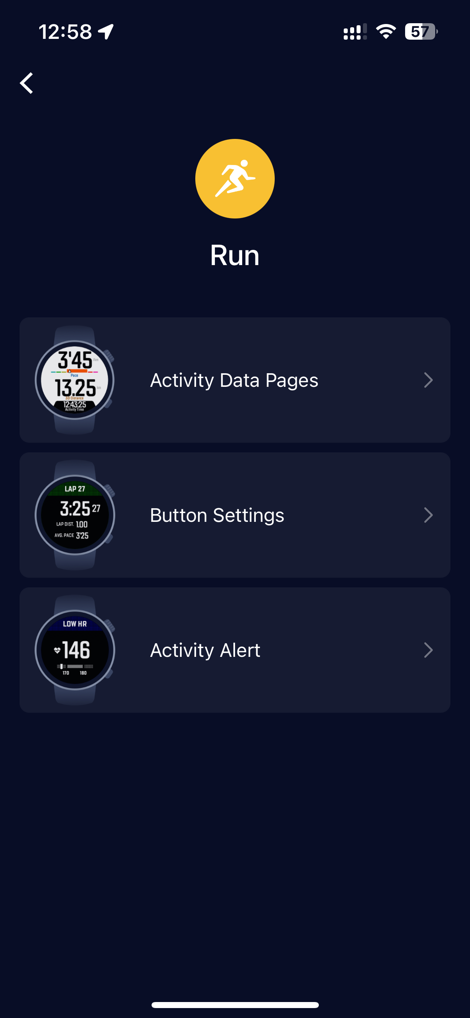

Once you’re ready to go, you’ll tap the button to start, and it’ll start displaying the data you’ve configured and recording the workout. Here’s a few data pages from my trail run today. Note that at present it’s incredibly difficult to take photos of the COROS Pace Pro screen without getting lines on the photo. These lines do not appear in real-life, just in cameras. Most other manufacturers actually spend time to ensure the screen refresh rates don’t conflict with common camera shutter speeds, but COROS seemingly hasn’t done that work yet (as no other AMOLED device is as impossible to photograph as the COROS Pace Pro).
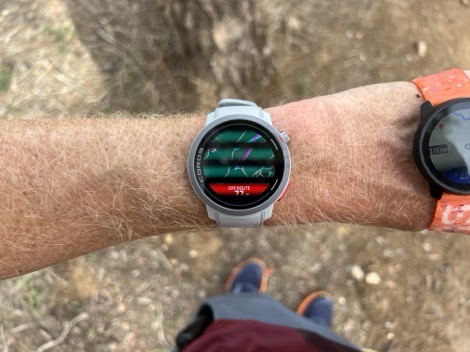
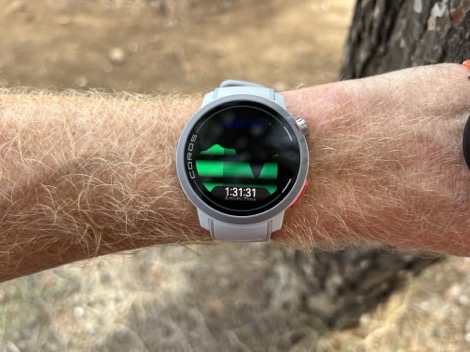
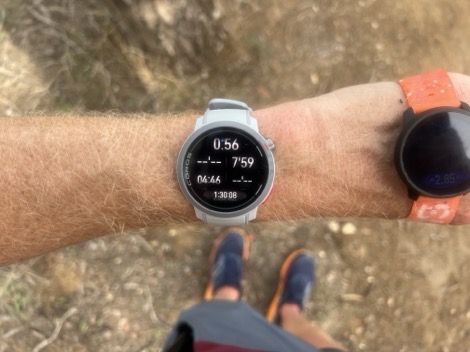
(The lines are exceptionally difficult in brighter conditions, such as those during daytime sunny conditions. It’s easier to photograph indoors or in very low light conditions.)
Once you’re done with your workout, you’ll see a summary of it on the watch, with plenty of stats to scroll through:
Likewise, you can see all of these details in the COROS app as well:
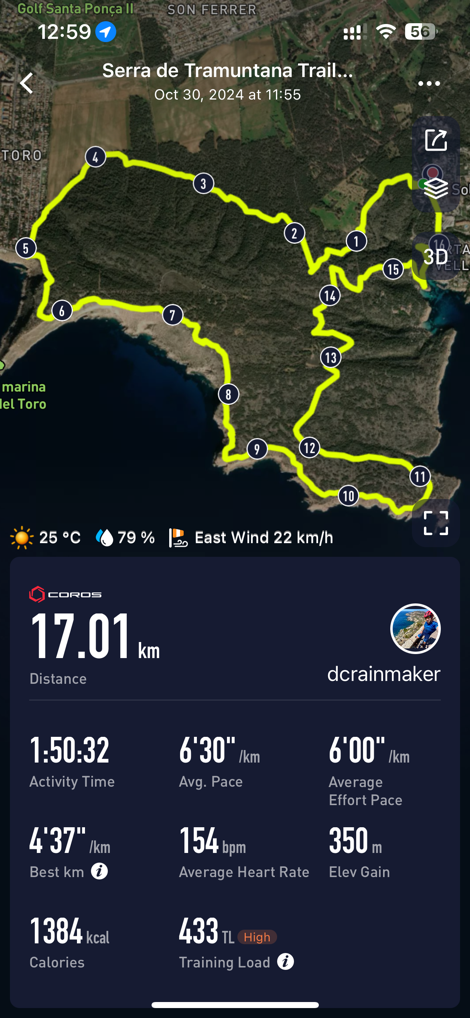
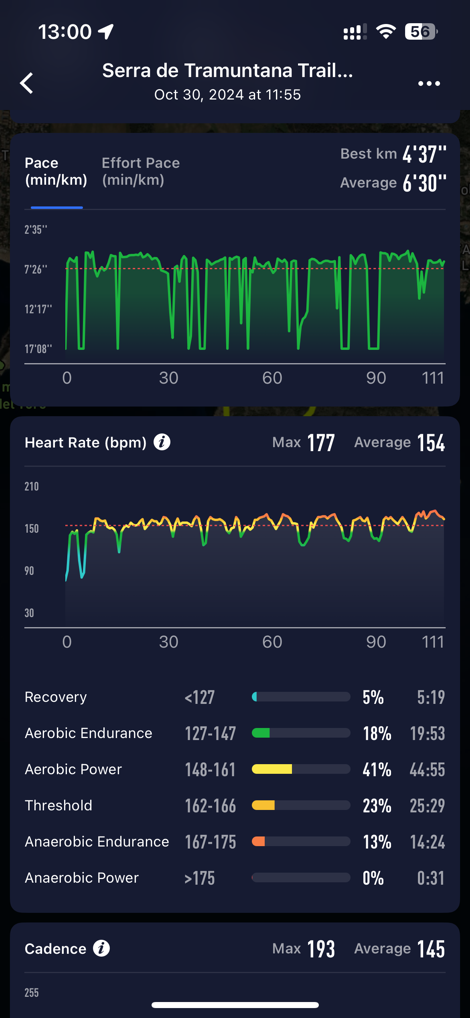
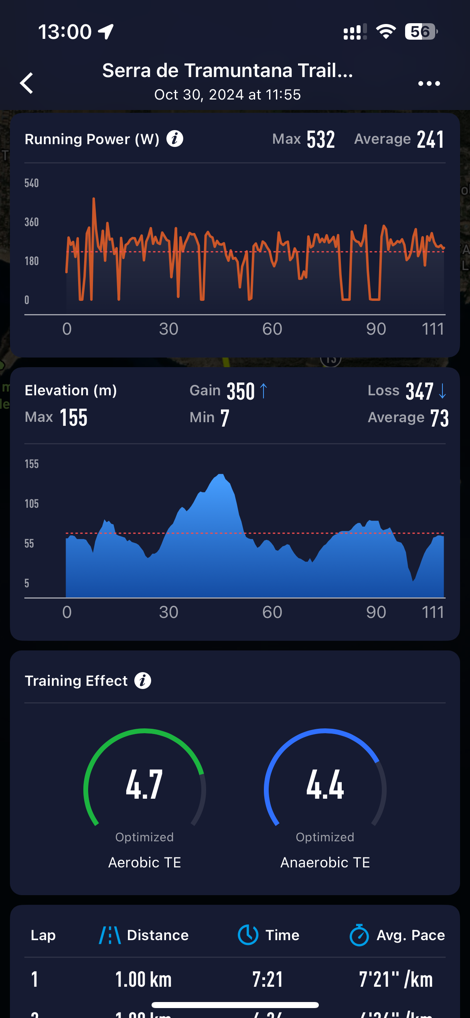
And of course, you can sync this data instantly to 3rd party apps like Strava, TrainingPeaks, and others, once you’ve set them up inside the app. In that same app (and on the watch), you’ll also see stats around training load, Training Status, Recovery, Running Fitness, Cycling Fitness, and more:


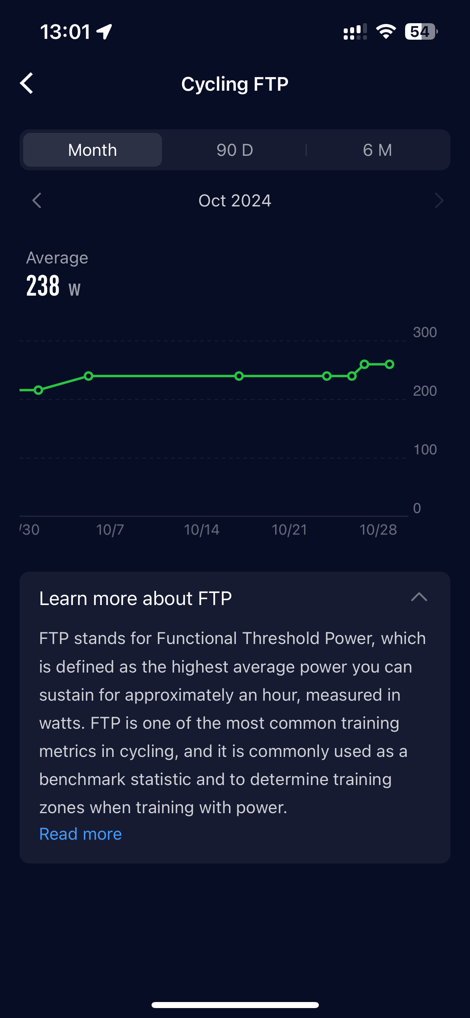
And you can look at your trended load and training status as well over various timeframes.
For aspects like Running Fitness, that’s going to depend heavily on you having some pretty hard interval workouts in there. While I’ve had a lot of interval workouts lately, none of them have been pain-inducing (I’ve been accompanying my wife on her workouts), thus, I don’t really have a super solid data set for it to guesstimate on. That said, for cycling, I’ve had a few more pretty hard workouts, and it seems to be pretty far below my actual cycling FTP. It predicts me at 259w, when in reality other platforms are putting me in the 290w range right now (which feels about right).
Likewise, the training load values it’s providing on recent workouts seem double that of other platforms (including Suunto, Garmin, and Polar.) For example, my trail run today on COROS was 433 (TRIMP), whereas Garmin was 227, Suunto was 208 (EPOC), Polar was 241 (TRIMP). The heart rate between these four devices was virtually identical (especially given two of them were connected to the same sensor/strap).
Overall, COROS does a good job at recording your workout data and showing you the data from it. However, I’d love to see COROS step up their focus on the training load pieces. Aspects like showing 7-day trending load, and understanding why the training load values are so much higher than their competitors, despite using the same theoretical formulas, are all areas to work on.
Mapping & Navigation:
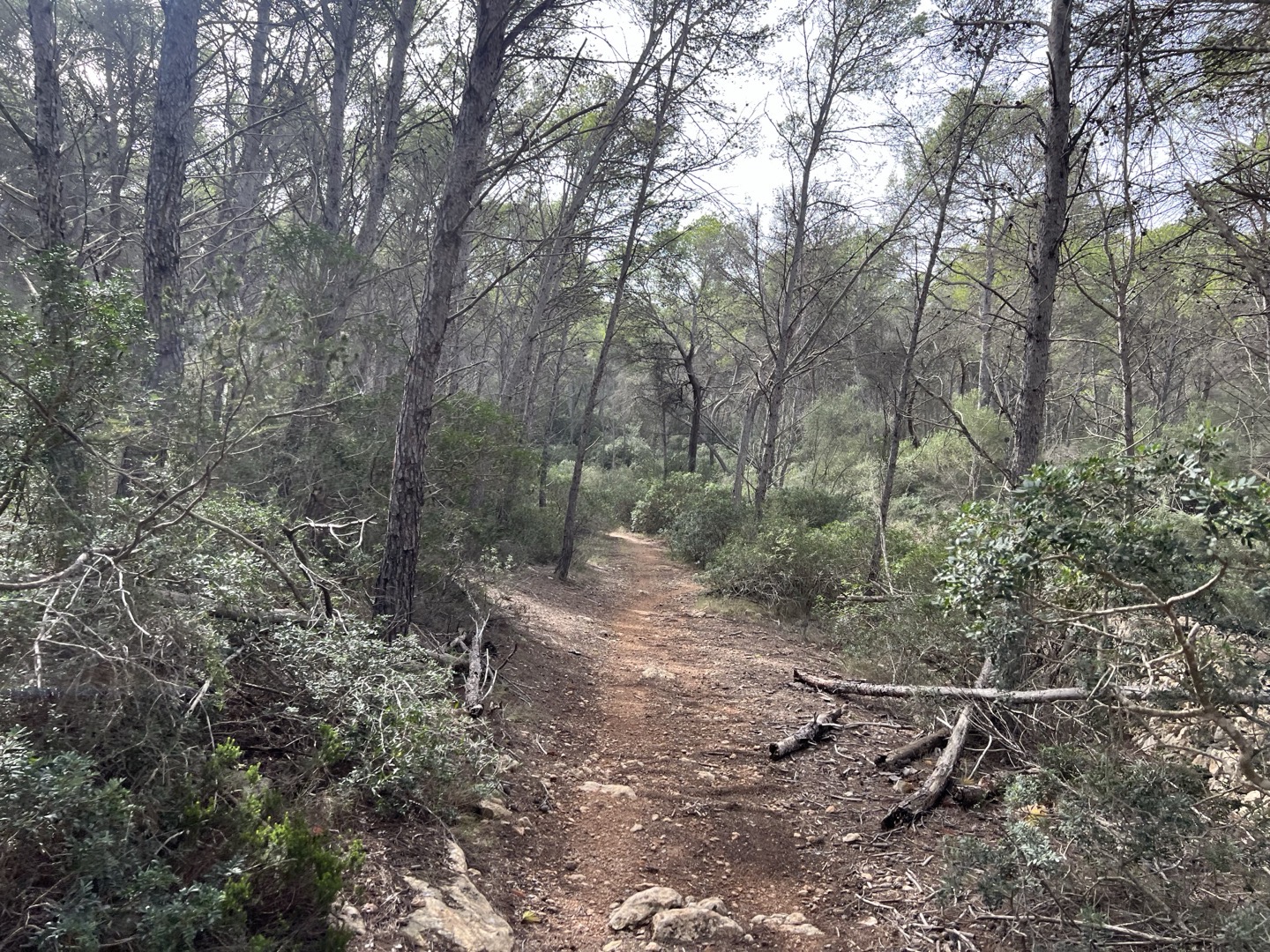
Outside of the AMOLED display, the addition of mapping is the biggest feature on the Pace Pro. Of course, given the price point (very nearly that of the APEX series), it kinda makes sense for it to be included.
The first thing to understand about mapping is the general mapping landscape in terms of map levels. Simply put: Just because a watch has mapping, doesn’t mean all maps are created equal. I’ve previously included this little chart/list in other reviews, which many people have said is super helpful to understanding the differences:
Breadcrumb trail only: This is when you don’t have a background map, but just follow a little trail on a blank screen – this is what the COROS Pace 3 has, as well as Garmin Forerunner 265.
Non-routable Maps (Pace Pro): This is when you have a map displayed behind your route, which shows terrain/trails/lakes/water/mountains/etc… However, this isn’t routable, so it doesn’t actually *know* if you’re on the ‘Deer Lake Trail’ – it just knows you’re on the breadcrumb track. If you stray too far from the trail, it’ll give you an off-course warning, but it cannot smartly re-route you back. It just tells you via compass how to find the trail again. This is what the Suunto Vertical and Race are, Polar Grit X2 Pro and Vantage M3/V3, as well as all COROS APEX Pro/Vertix series, and COROS Pace Pro are.
Routable Maps: This is the ‘highest’ level, and is when the watch can actually route on the trails by itself, if needed. It knows you’re on Deer Lake Trail, and the next trail coming up is Big Bear Trail. And it knows if you miss that turn, whether or not you need to turn-around, or can catch-up later on. This is what most of the higher-end Garmin devices are (any devices with mapping, like the Fenix/Epix series, or higher-end Forerunners).
Now, just because the COROS units don’t have routable maps, doesn’t mean they aren’t useful. Far from it. I only use routable maps on a hiking device perhaps once per year (admittedly, when I do use it, it tends to be super important – like escaping an incoming storm in the high Alps). Still, I don’t see it as a mission-critical feature for my usage. Note that for cycling, I do see it as more critical, given the vast differences in road cycling versus hiking on trails (distances traveled, speeds, variability, etc.…).
So, let’s look at today’s trail run as a simple example of how things work. First up is creating the route. You can do that in Strava, Komoot, the COROS app itself, or any GPX file you want to import. In my case, I created the route in Strava, and then it synced to the COROS app. You can see it, along with other routes, here in the app:
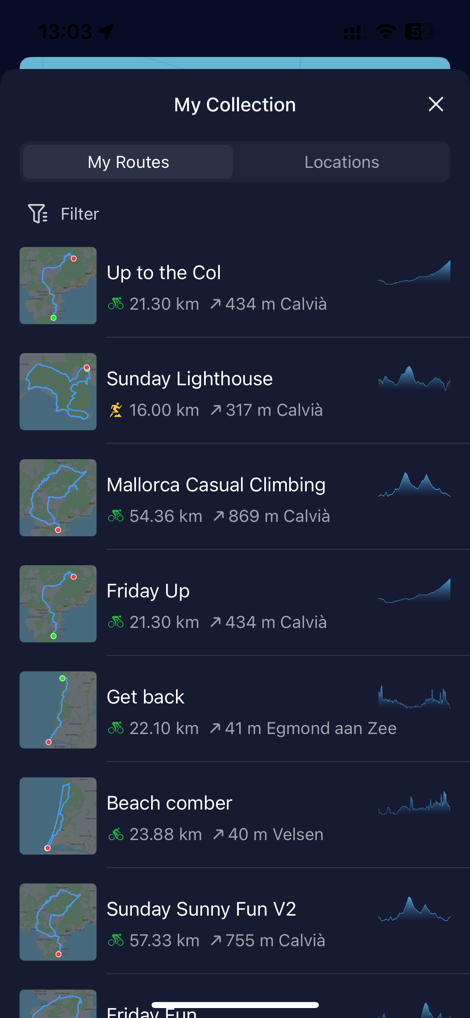

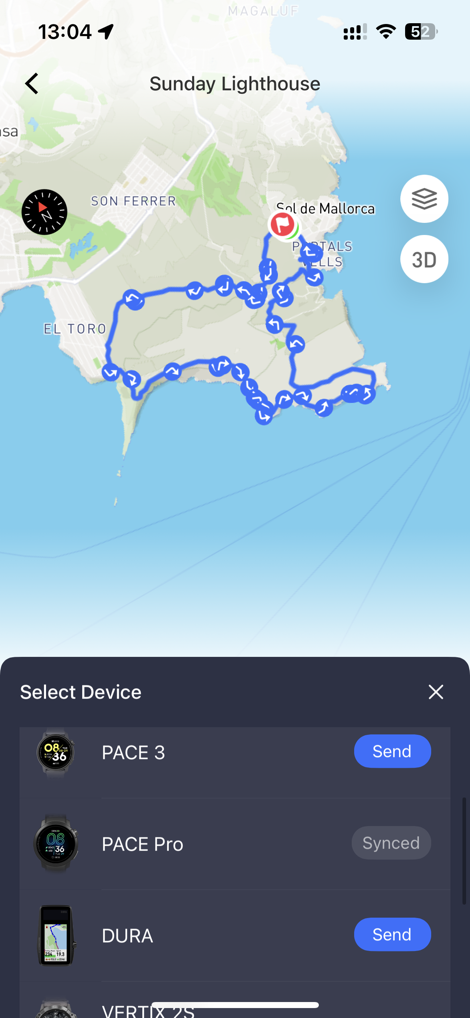
From there, you’ll need to manually select it, and sync it to the watch. Again, I’m going to be nitpicky there: There’s just no reason for that. When I create a route on Strava/Komoot/etc, and it’s starred/favorited, it should instantly sync/push all the way to the watch. They’ve got 32GB of storage on there, enough for thousands of routes. Garmin, Polar, Wahoo, etc… all operate this way – instant sync.
Once synced, you’ll have it on your watch to execute. To do so, first select the sport profile you want to use (such as running or cycling), then within that, select navigation and choose your route (in my case, Sunday Lighthouse):
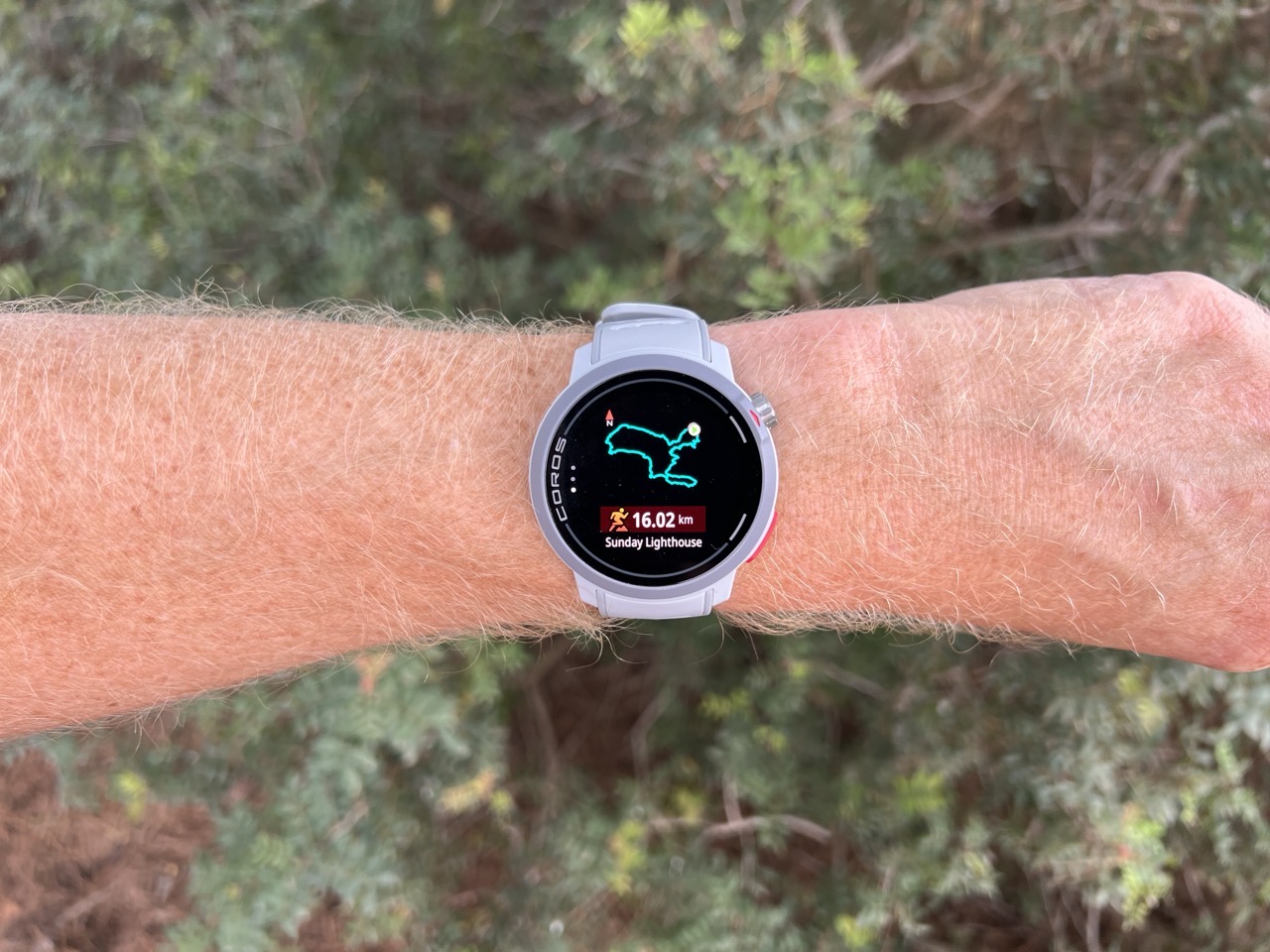
You can see details about the route, including the distance and elevation profile. You can also toggle on/off turn-by-turn prompts (on by default), as well as off-course alerts (called deviate alerts).

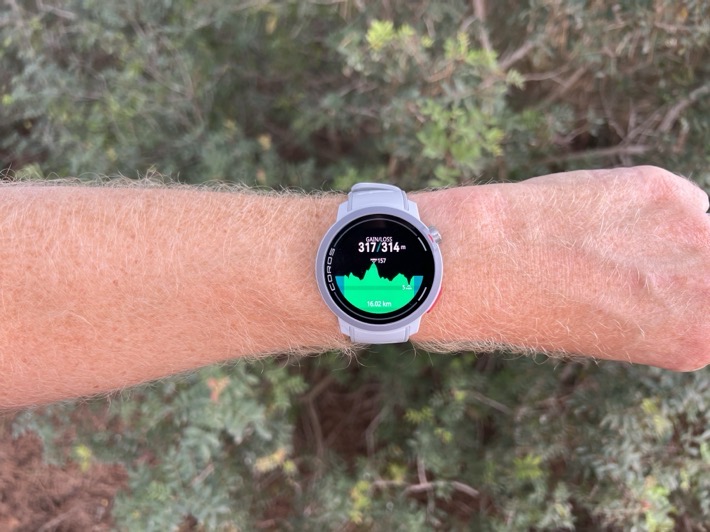
Then, once you’re out on the route navigating, you’ll see your course overlaid on the underlying maps, and an arrow with the direction you should be traveling. As you approach each turn, you’ll get a briefly appearing arrow on which direction to go (I don’t understand why this arrow doesn’t just stay present like every other company):

(On a two-hour trail run, this is the single frame that is usable without black lines. It’d be better if I went out at sunset, but honestly, COROS should have spent the time to ensure outdoor daytime photos of their watch are usable. Every other company does.)
If you go off-course, you’ll get a ‘Deviation’ alert after about 50m. This lets you know that you need to re-think your life (and trail) choices and change things. The COROS watch won’t re-route in any capacity, so it’s up to you to fix things and get yourself back on the line.
Still, having the off-course alerts and underlying map make it far easier to route out on trails and fix errors. You can easily see on the trail map the ‘wrong’ trails, so you know you’re on the ‘right’ trail. Speaking of seeing things, you’ll also see where you are elevation-wise on your course.
Now, talking about those maps COROS has, there’s topographic details, but no other points of interest or labels on them (again, COROS says that trail/road labels are coming in Q1 2025). So at least as of now, you can’t see the road/trail/lake/mountain/etc names as you would on Garmin’s maps. In most cases, that’s not a huge deal, to be honest. Most of the time I’m in various foreign countries, and these names are rarely super helpful to me (since I can’t pronounce them anyway and rarely matter to the actual route navigation). But again, if you were talking road cycling or cycling in general, these are much more important.
You can download maps by choosing them within the app using the Map Manager. All the maps are free, globally. One of the things I like most about COROS’s maps though is the fact that I can actually download them over Bluetooth. Every other company requires downloading map tiles via WiFi, due to the larger size of the map tiles (Bluetooth isn’t good for large data, just small bits). In COROS’s case, they’ve sub-divided up the world into a gazillion map tiles, so you just select the tiles you need, and choose to download via WiFi or Bluetooth:

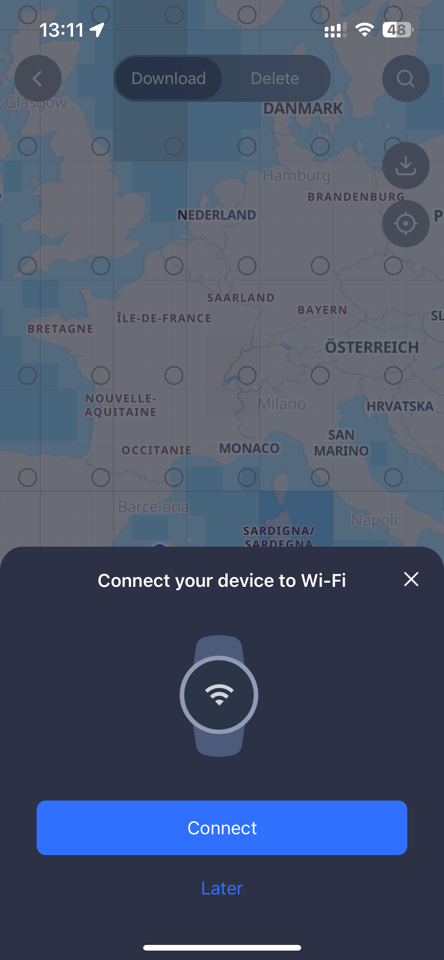
Again, about 90% of the time I realize I don’t have the right tile when I get to my destination country, and so the ability to quickly do so via Bluetooth from my phone is a massive ass-saver compared to trying to get them via WiFi (as watches can’t leverage hotel networks due to the sign-in prompt).
As with the training load bits, COROS has the bulk of this stuff right. Yet, there’s still good room for improvement, especially around the route/course workflow, and I’d love to see a ClimbPro-like feature that automatically shows each upcoming climb, such as they have on their Dura cycling computer (and their competitors have too, including Suunto & Garmin for hiking/running).
Accuracy (GPS & Heart Rate):
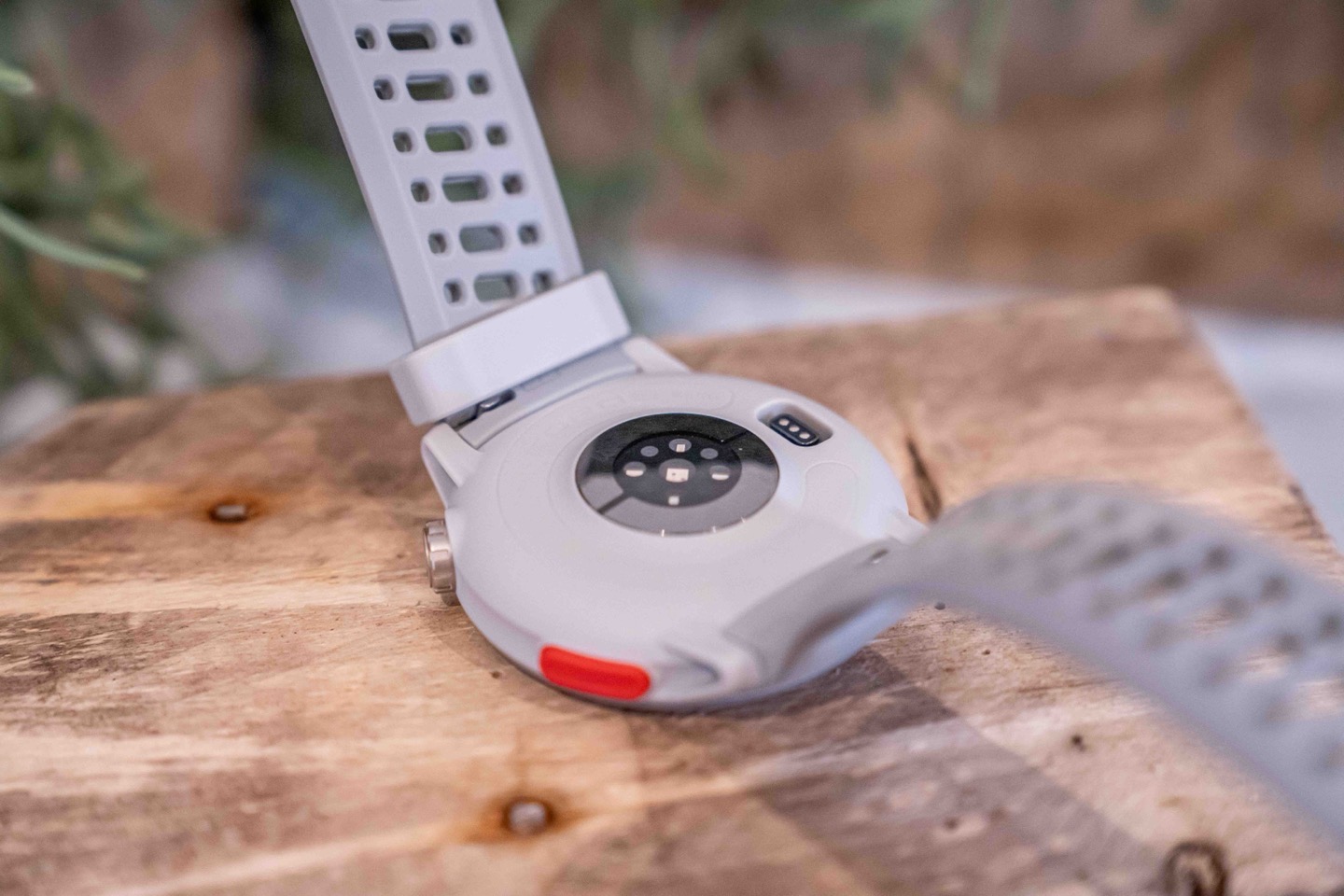
First, we’ll start on the heart rate side with something easy – a 45-minute indoor cycling trainer ride. This is generally the easiest thing for optical heart rate sensors to handle, since you have minimal hand movement, and no road vibrations to deal with. As you can see, things are almost identical here versus the chest strap, just a slight bit of delay on the recoveries for a few seconds, somewhat common with optical HR sensors, but mostly good.
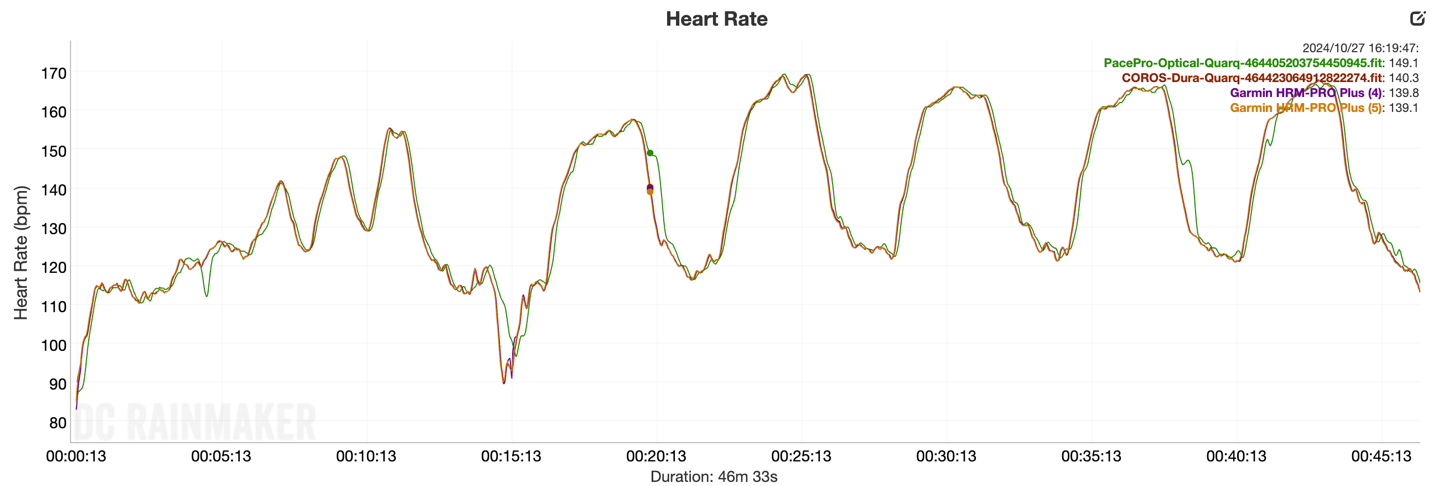
Next, let’s kick it up with some outside running, this time a nearly 2-hour-long trail run. This had plenty of ups and downs (both intensity and elevation) to evaluate. Thus in effect, lots of little intervals in terms of intensity. This is compared to both a chest strap, the Whoop 4 optical HR sensor on an arm band, and the Polar Vantage M3’s optical HR sensor:

As you can see above, pretty darn similar across the board. And if I zoom into one of those impromptu intervals, all of them trend fairly close together:

Ok, so let’s step up – here’s an interval workout from a few days ago. This one includes 2-min, 1-min, and 30-sec intervals. As you can see, it’s very very close:

About the only quibble I’d have is the recovery on some intervals is a bit delayed, but again, not enough that I’d be concerned with it:

Meanwhile, a different day for some longer 12-minute intervals, it’s basically spot on, no complaints:
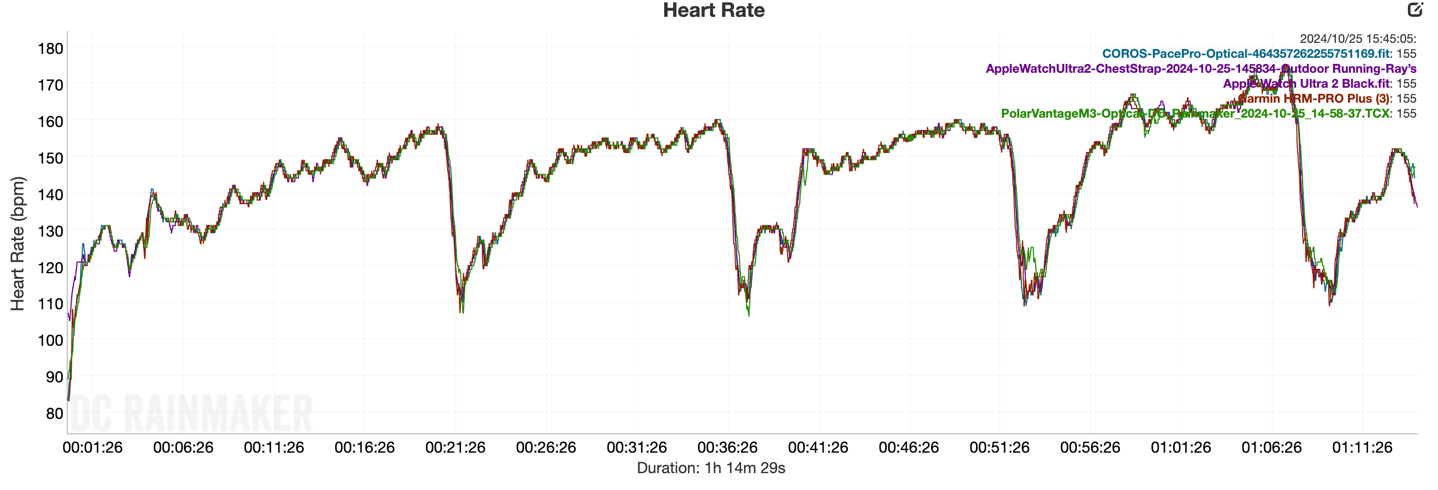
Lastly, one of the most difficult things is outdoor cycling, so, let’s take a look at that on this nearly 3-hour route up in the mountains:

Yup, the struggle bus was real there. Pretty much constantly unusable data across the board from the COROS Pace Pro:

Definitely one of the worst optical HR performances I’ve seen this year in outdoor cycling.
So, taking a look at the GPS side of things, we’ll start off easy like with the heart rate bits – on this looping interval run. This particular run didn’t have much in the way of dense trees or buildings. It was rather straightforward:
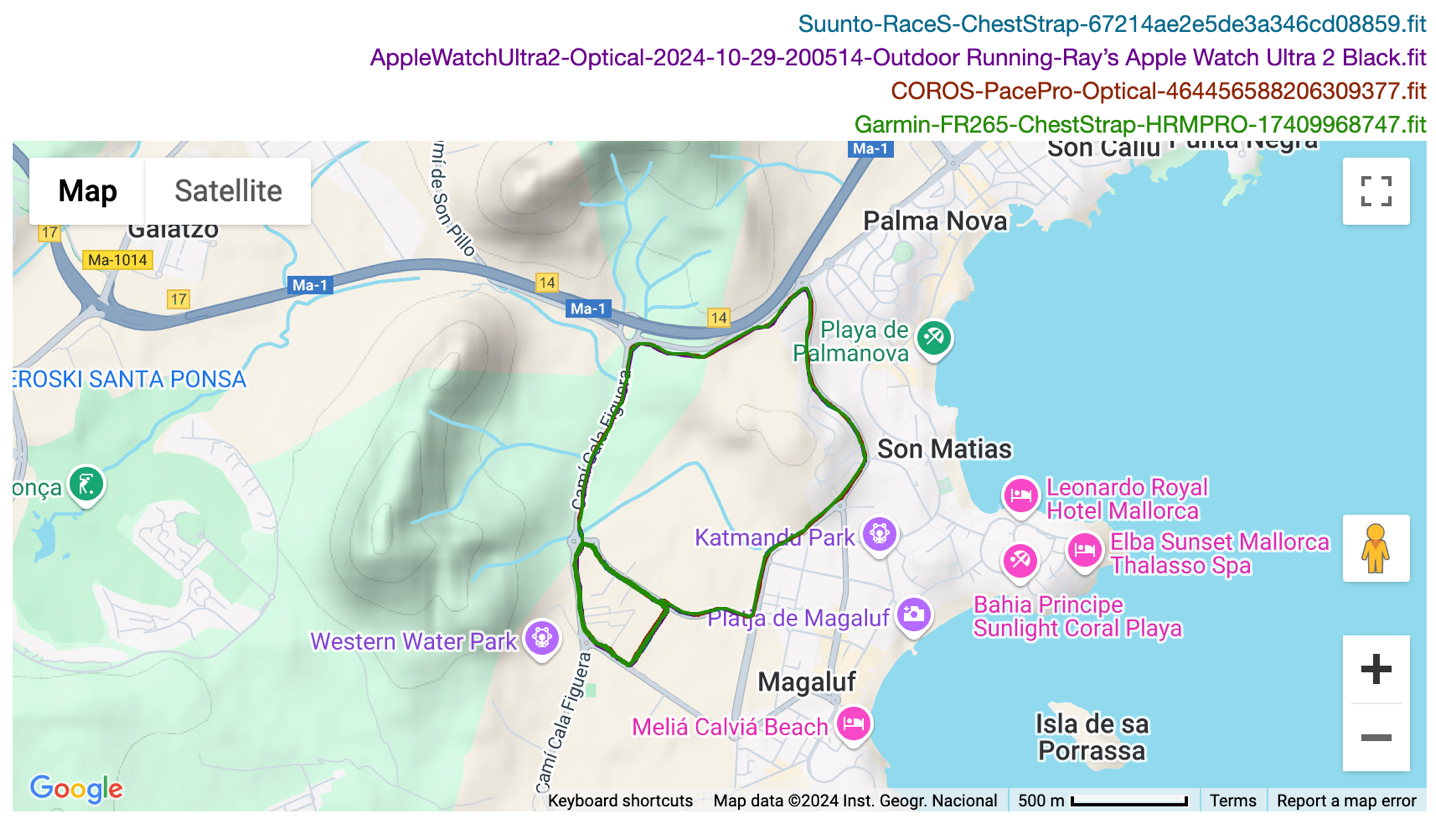
Still, it was notable to look at the cornering, and overall it did quite well here. It seemed to have tighter tracks each loop than some of the other units – I ran in the exact same spot each time on this section (a relatively skinny sidewalk section):
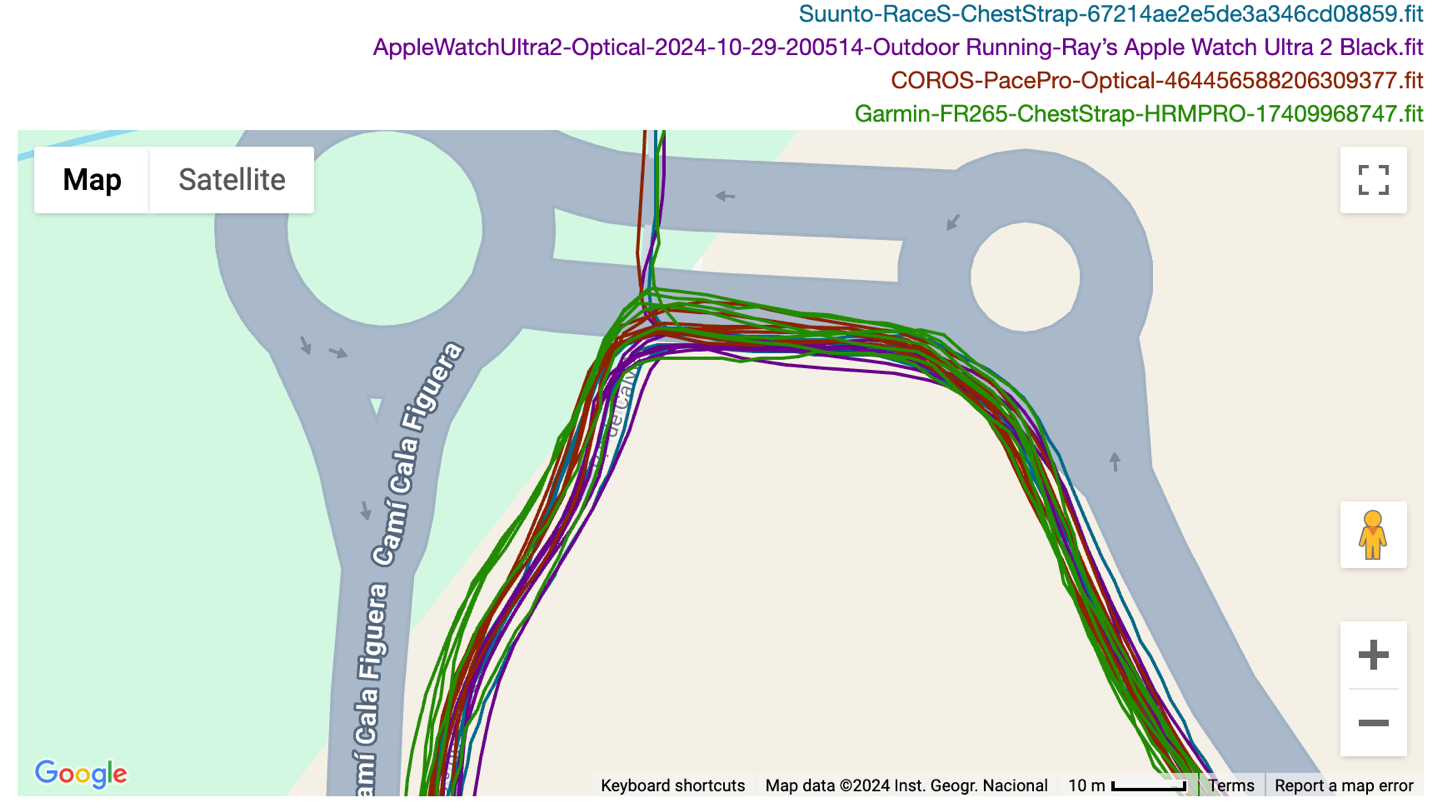
Likewise, a few days earlier on a relatively similar route with much overlap, perfect:
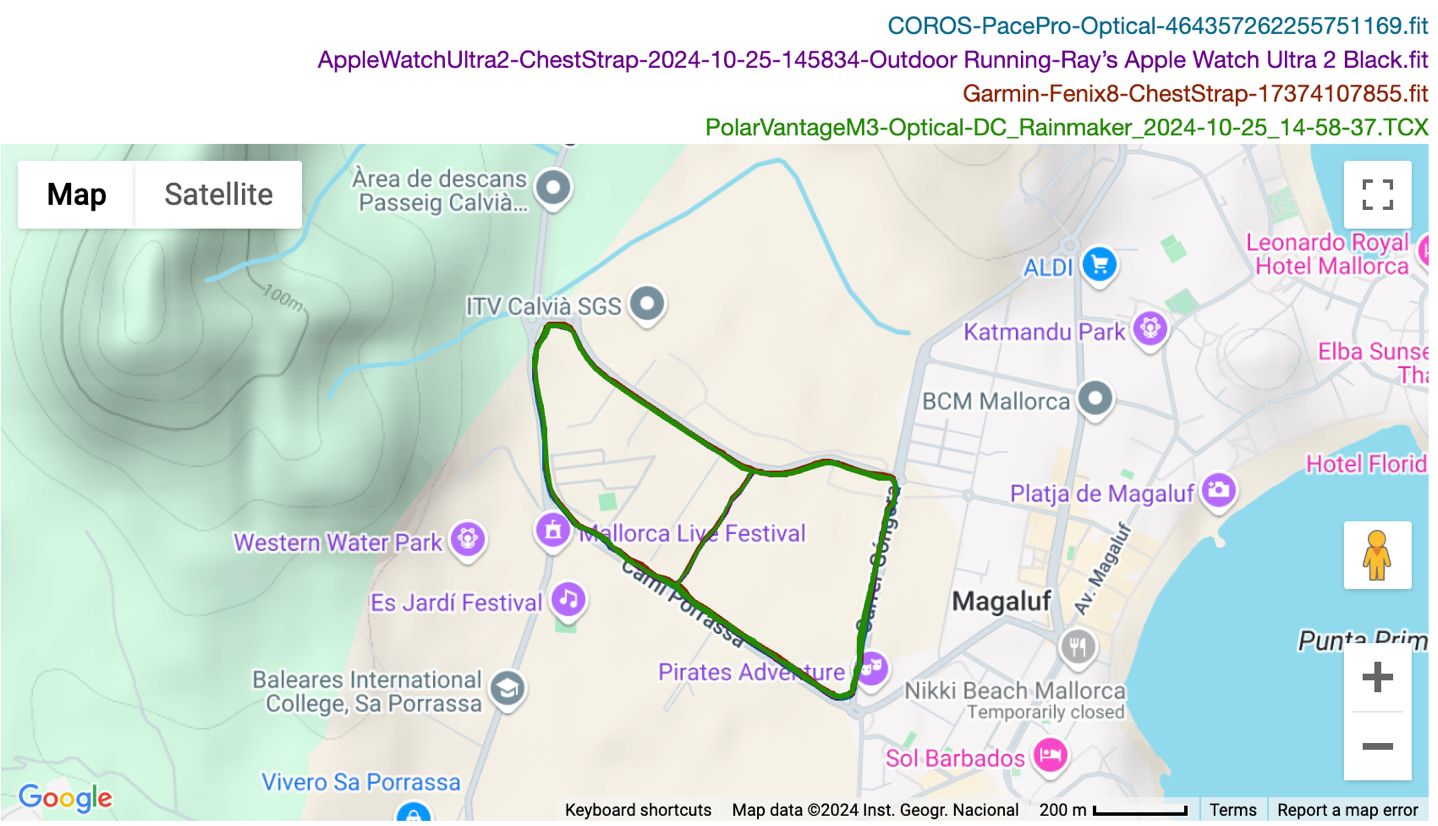
Next, looking at GPS, starting off with that trail run, again, things at a high level look basically identical to the Garmin Forerunner 265, Suunto Race S, and Polar Vantage M3. All of these were in multiband mode:
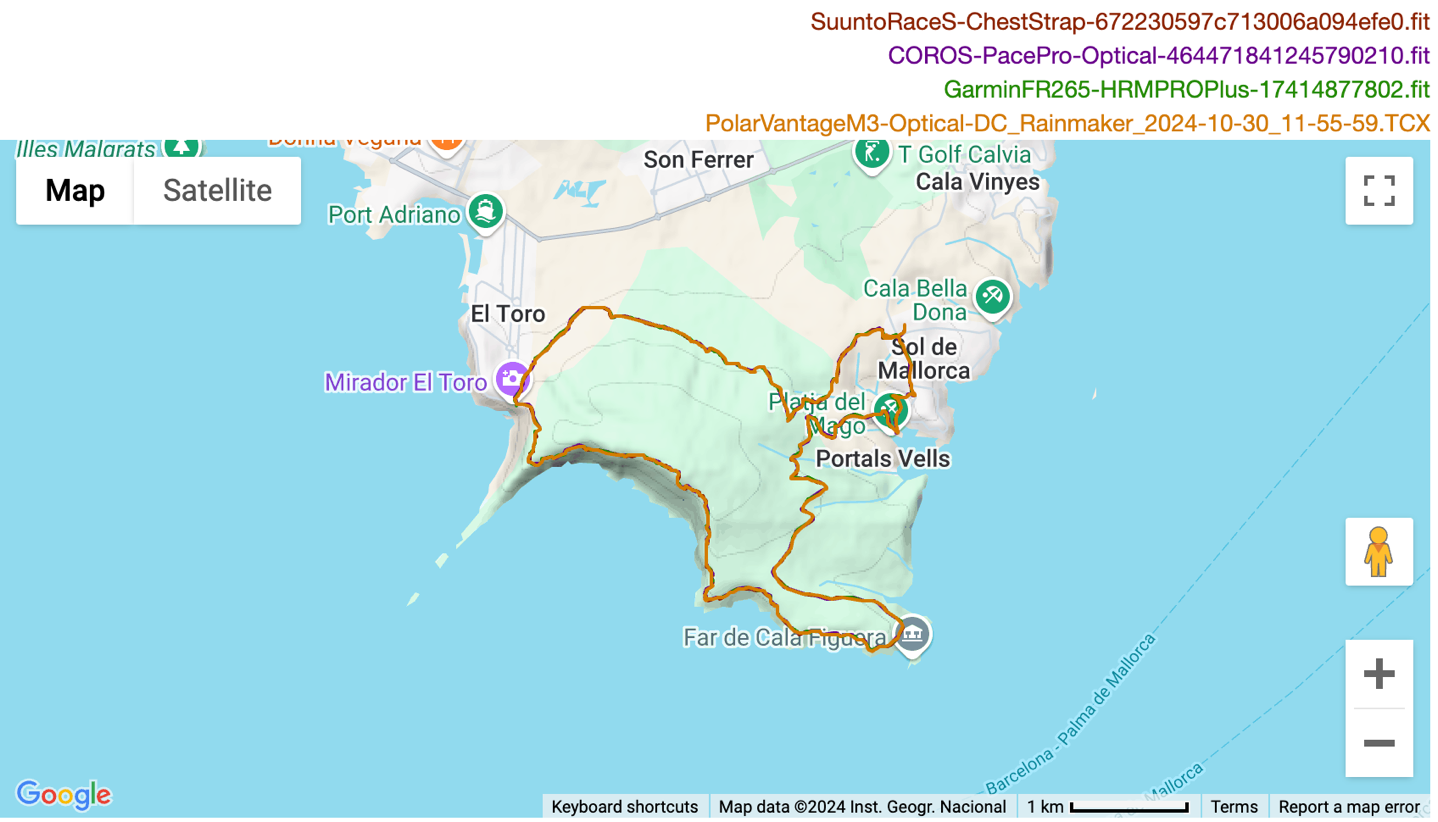
If we zoom down a bit into the trees, we can see that at a medium zoom level, again, things look pretty similar:
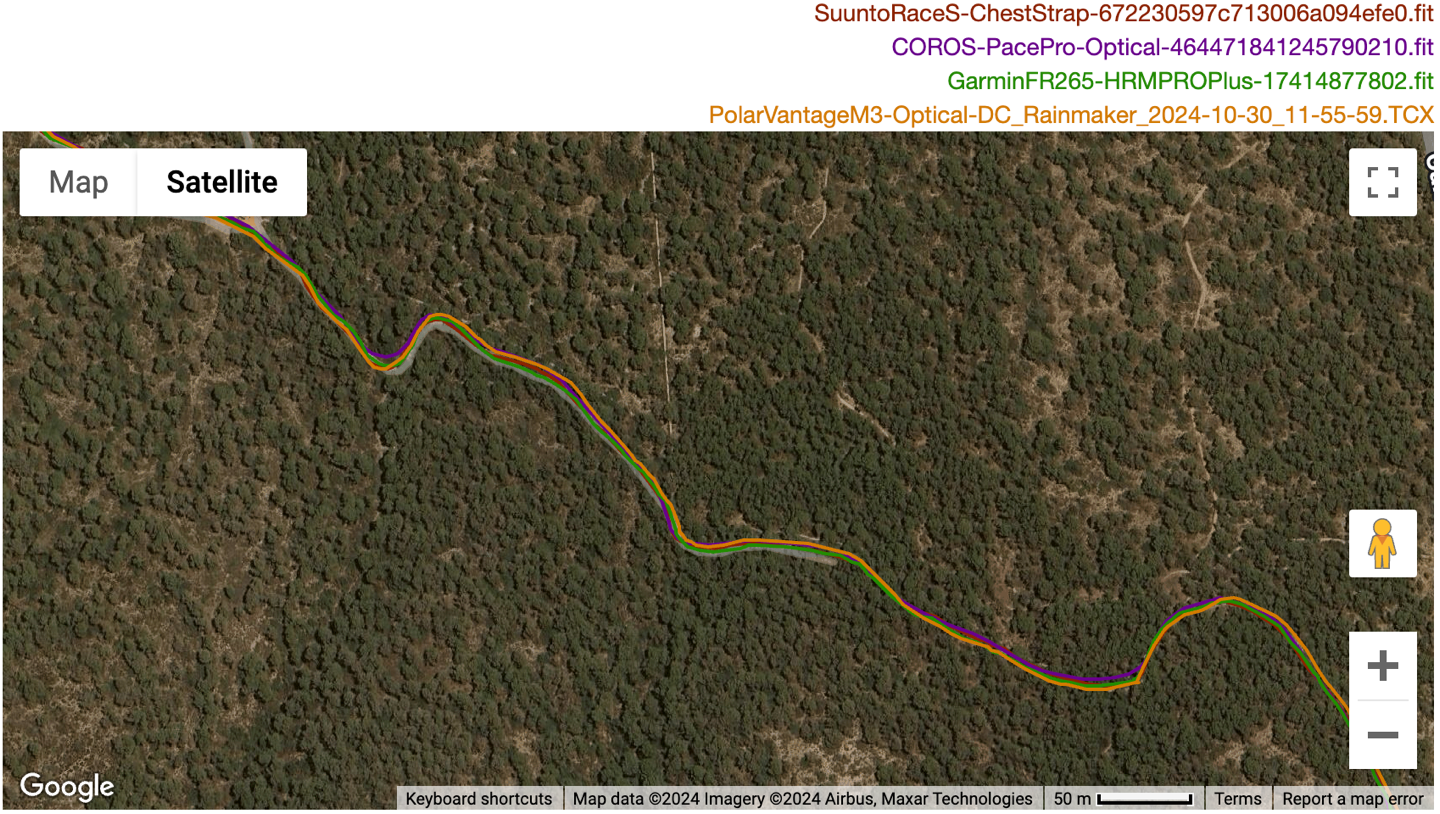
However, when I zoom all the way down, for whatever reason, the COROS Pace Pro is just slightly offset from the rest. Not much, perhaps 2-4 meters at most. But it is consistently offset virtually the entire run (you can click the link to see/move around the full map).
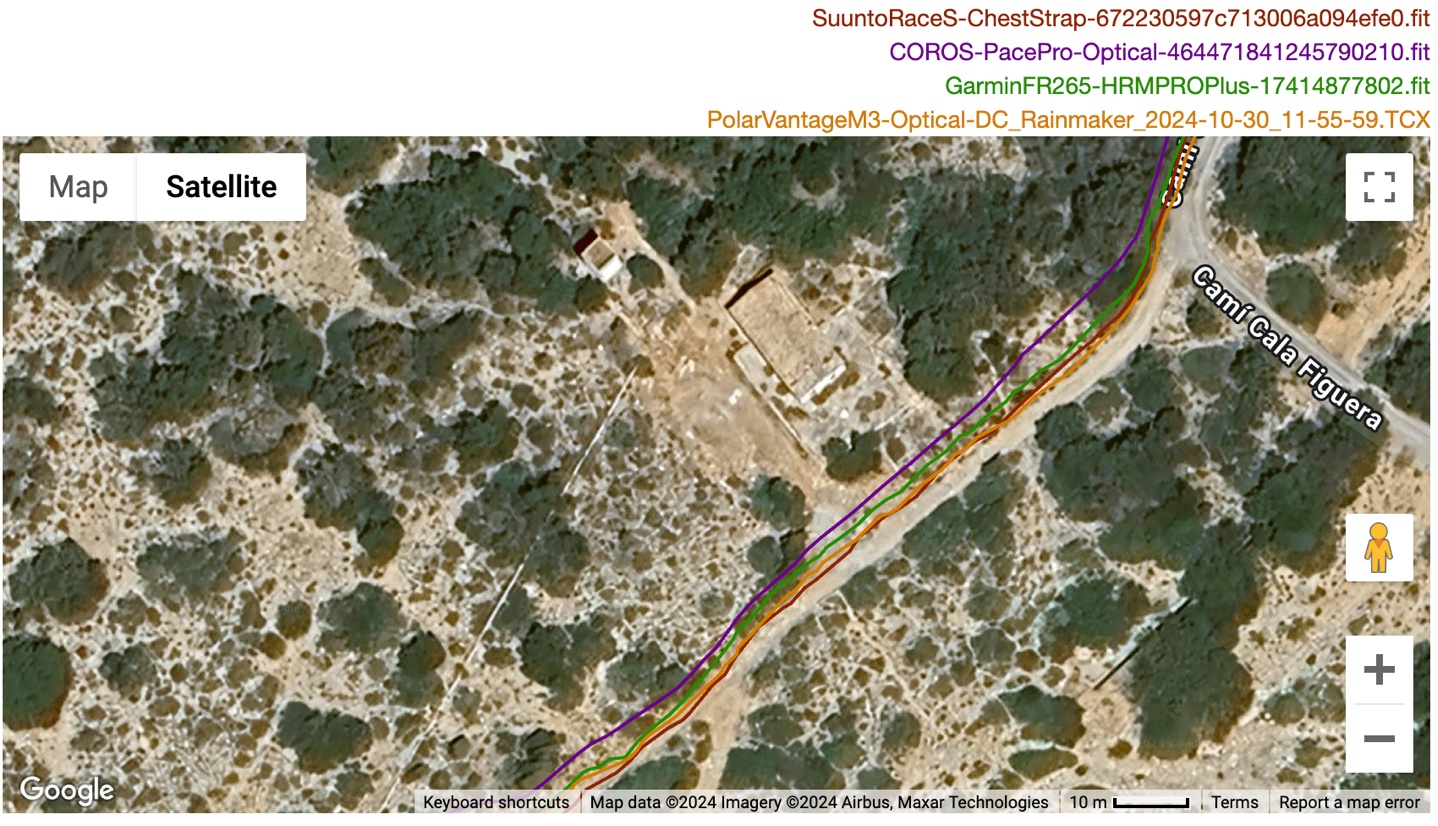
Increasing complexity, we’ll head up into the mountains on a road ride. This route has plenty of very challenging switchbacks against mountain cliff faces, which were both going up as well as going down at speed.
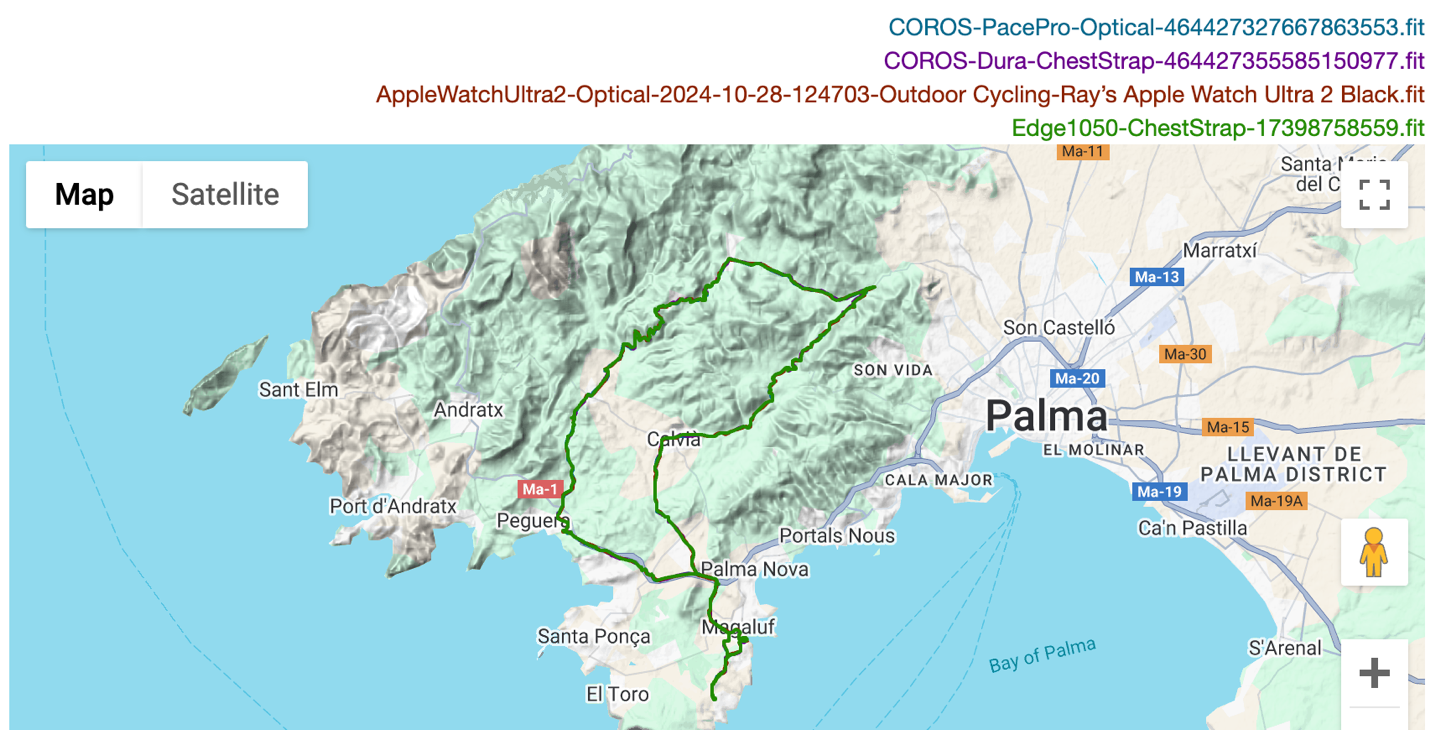
Zooming in on an easier tree section first, looking pretty good:

And then another busy switchback section along cliff edges, and also, very solid:
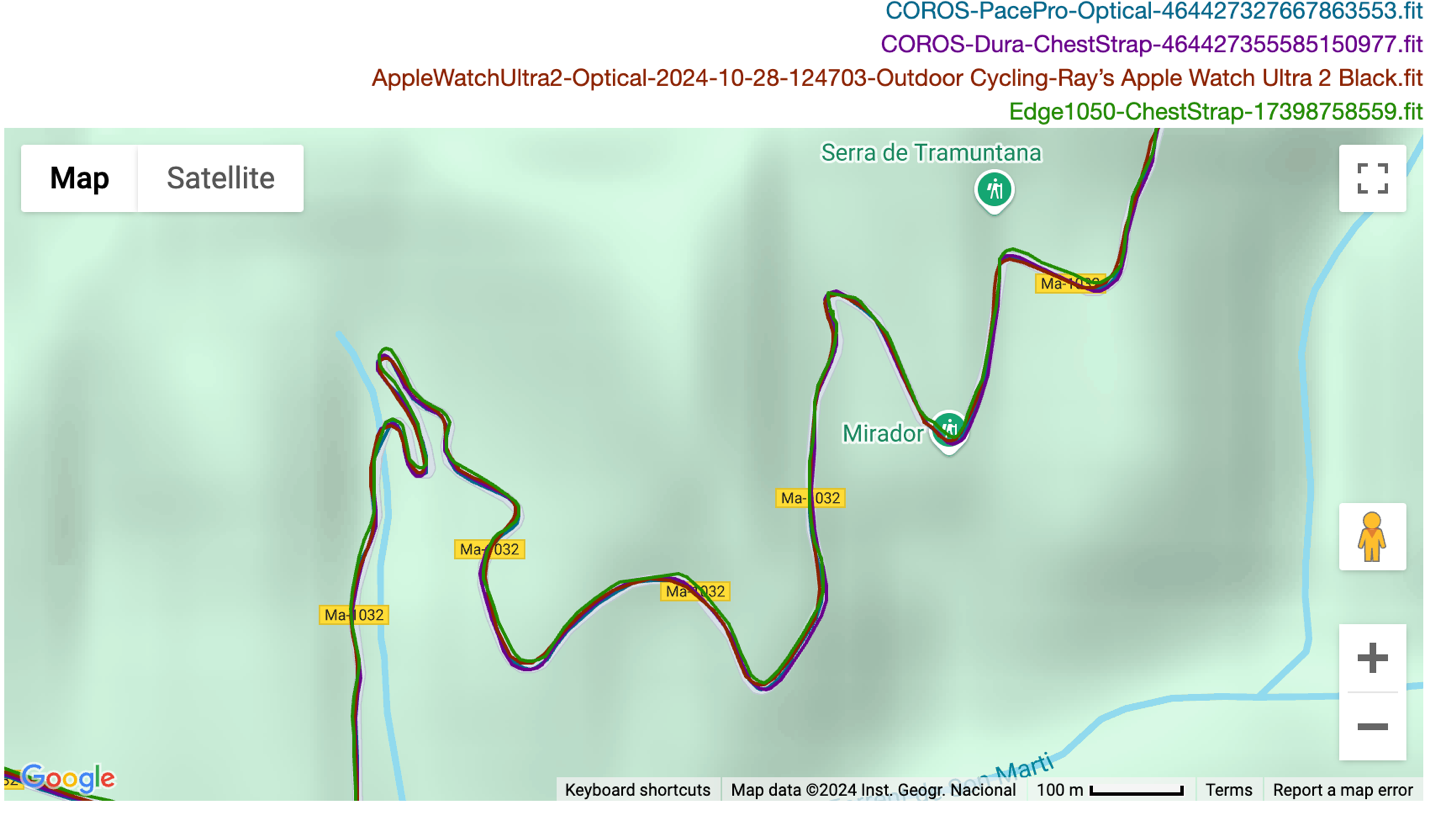
In fact, it’s keeping up perfectly with dedicated cycling GPS computers without issue:
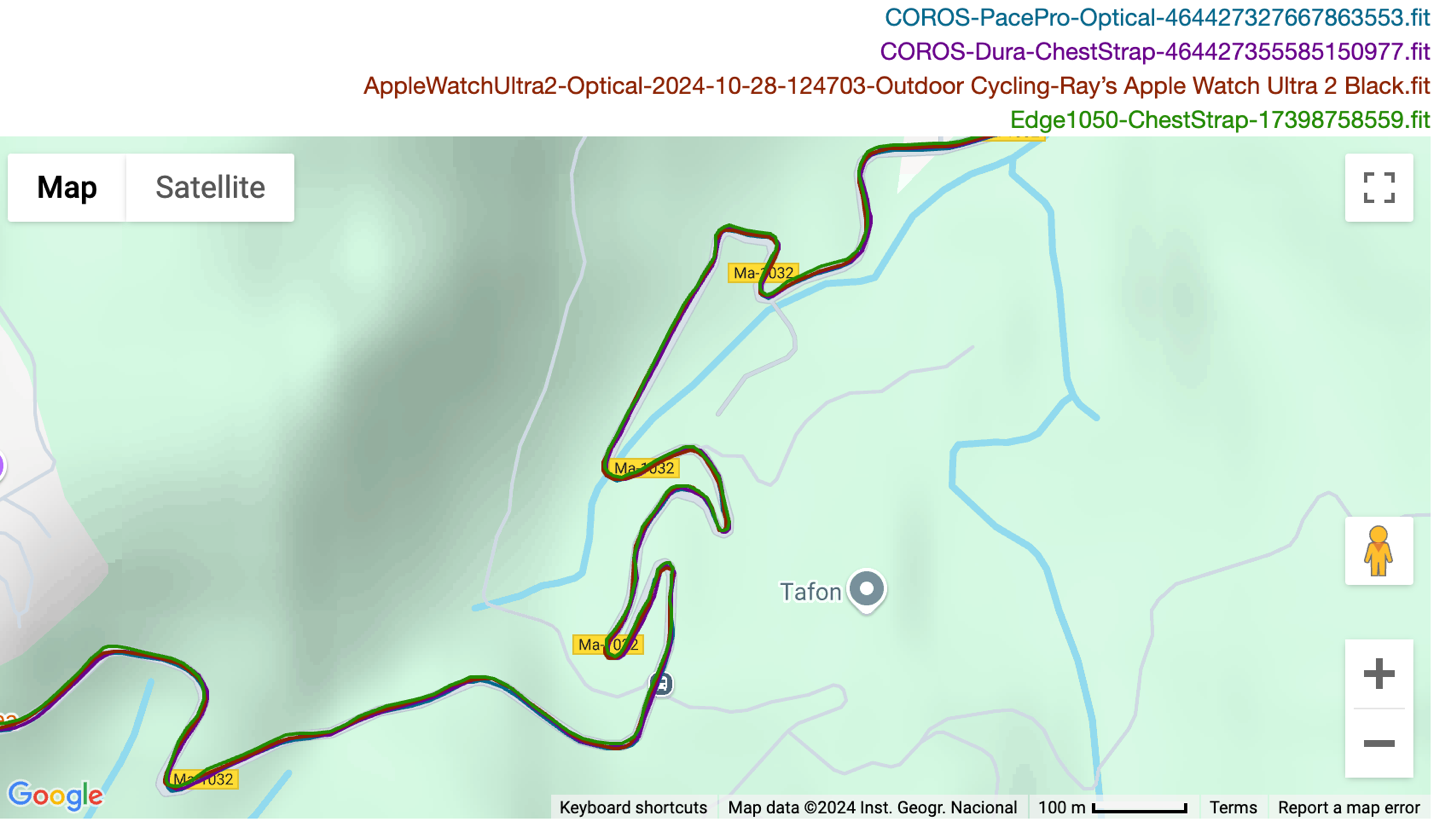
Lastly, we’ve got an openwater swim. In this case the COROS Pace Pro on one wrist, and the Garmin Forerunner 265 on the other wrist. At a high level, this looks to be a vast improvement over…well…every other COROS watch to date, which have all failed my openwater swim tests badly, so this is a huge improvement:
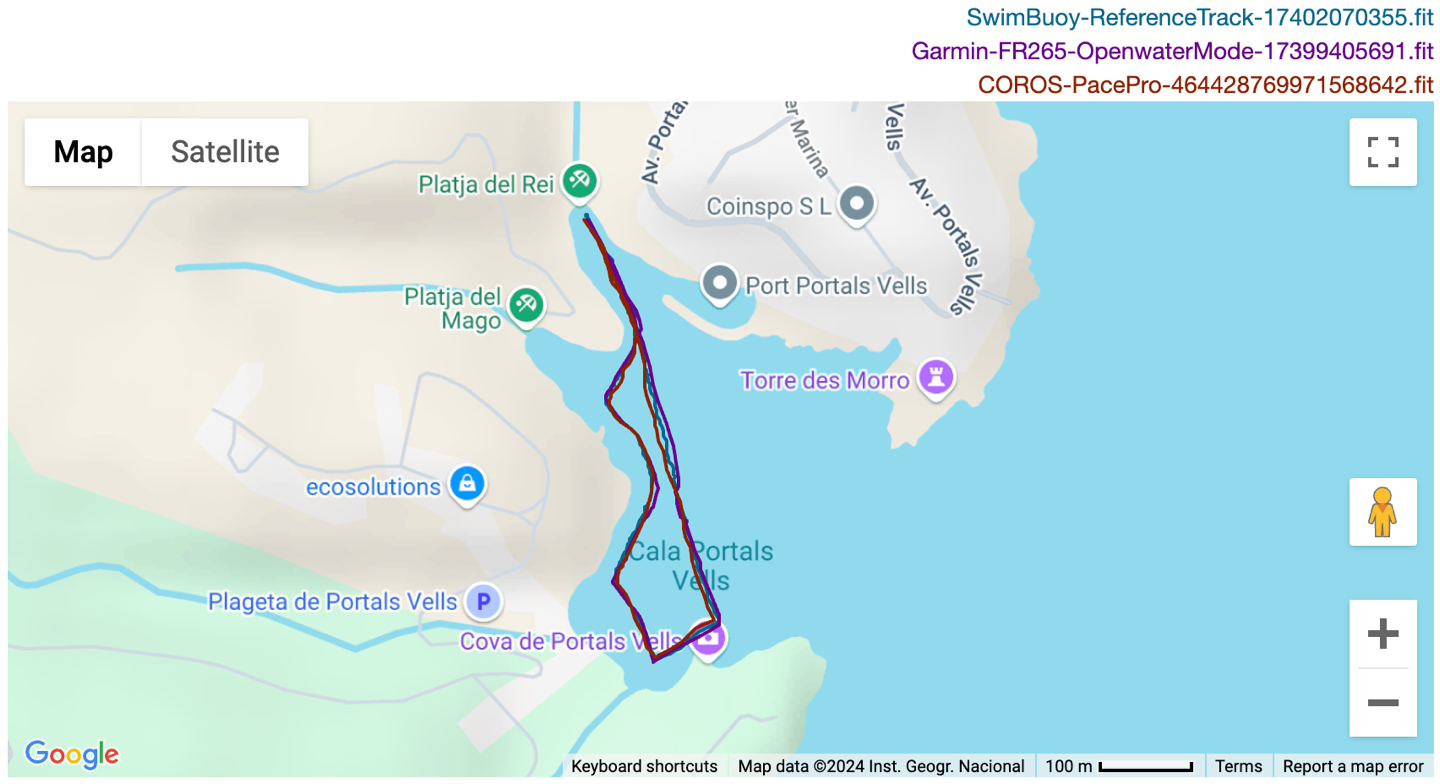
If we zoom in, we see a little bit of corner-cutting. Not drastically so, but it’s there. Still, for COROS, this is a huge leap forward, and the first time I’ve ever seen a usable swim track from the company:
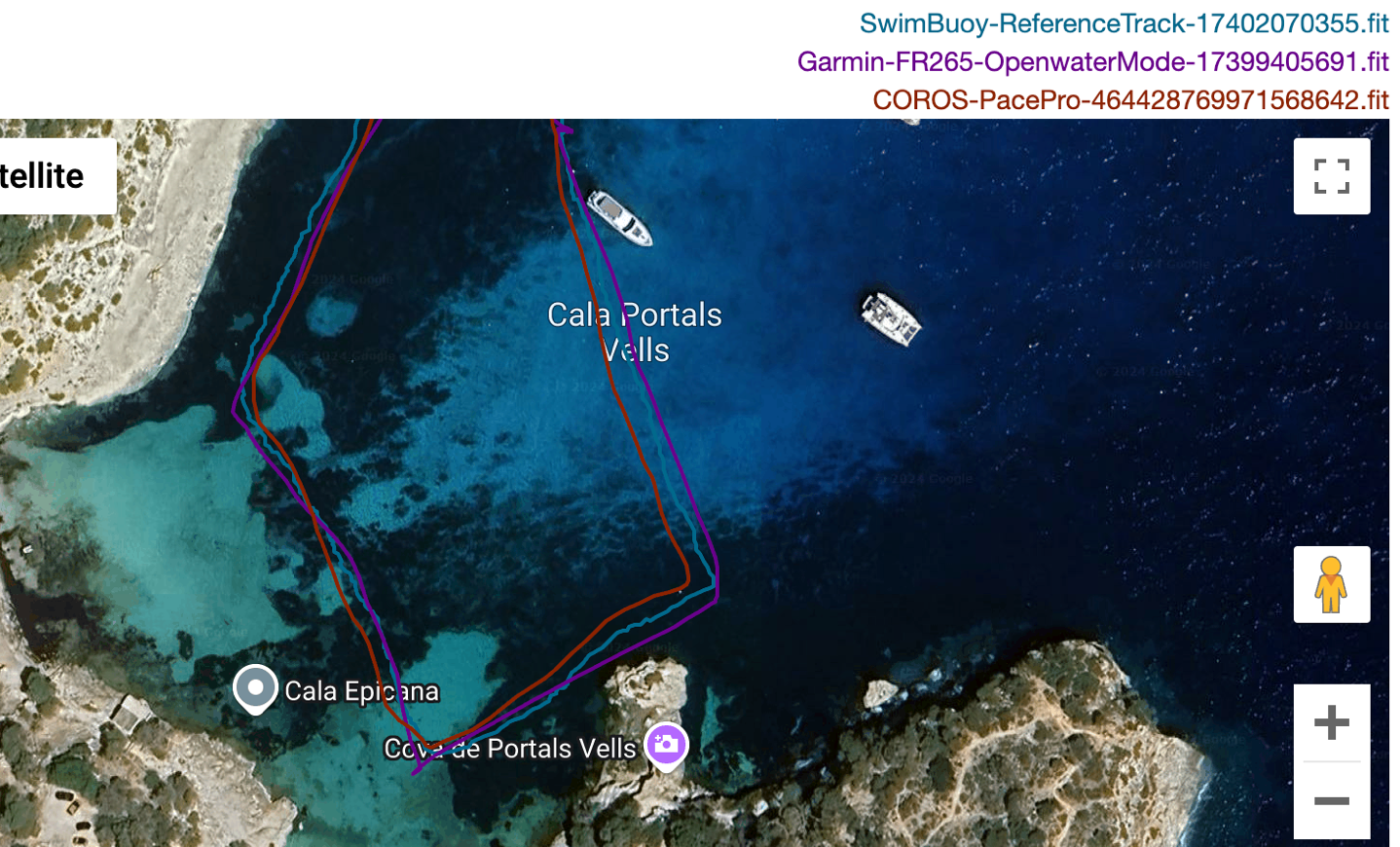
Overall, I’m pretty happy with both heart rate and GPS performance here. The only problem here is outdoor cycling, which many watches can struggle with, though the Pace Pro definitely struggles more than most. But otherwise, it appears solid.
Oh – and as for battery life, well, that’s a bit trickier. I was seeing some vastly bad battery life performances on a recent bike ride (~10%/hour), and brought it to the attention of COROS. In doing some dives into my logs, they found a rare bug that can basically cause the GPS chipset to go crazy. They’ve introduced a fix for that, which will slightly reduce GPS accuracy in certain scenarios, in the meantime. That fix will go live today for all users. When I don’t run into that GPS condition, in dual-frequency GPS, I’m getting roughly 5%/hour battery burn. Though, that trail run above indicates a slight offset, which may be due to the lower accuracy mode required to sidestep the GPS battery burn issue. COROS says they they have a real fix in the coming days which will get the GPS accuracy back to the original modes, without the battery burn.
Wrap-Up:

Ultimately, I think COROS has built a very solid watch here, arguably one of their best watches I’d say. The screen is brilliant and works well, and the GPS and heart rate is probably the best we’ve seen on a COROS watch (no matter the price point). Speaking of that price, while it is indeed higher than the original COROS Pace 3, it’s in line with the above watches, Suunto Race S ($349), Polar Vantage M3 ($399), and Garmin Forerunner 265 ($449). Those watches all have slightly different features, some more, some less. For example, the Garmin Forerunner 265 lacks maps but has other sports features as well as streaming music platforms and contactless payments. But if you want maps, it’s the wrong choice. I’ll dive into all that stuff in my next post/video, as I’ve been using them side-by-side to compare.
In any event, the Pace Pro is undoubtedly going to kick off the AMOLED transition for COROS. While they said they’ll always keep MIP-based models around, I suspect like Garmin that’ll basically only end up being a small fraction of their units. Ultimately, probably just a single product line. With battery life on AMOLED units starting to rival that of MIP-based units (especially in GPS modes), there’s simply less and less reason to have a MIP-based display. Even more so as companies nuance that backlight to avoid it being distracting (an area that COROS does well for its first attempt, but leaves a little bit of polish to finish up on).
Ultimately, this watch is right there in the mix and highly competitive, and you won’t go wrong with it.
With that, thanks for reading!
Found This Post Useful? Support The Site!
Hopefully you found this review/post useful. At the end of the day, I’m an athlete just like you looking for the most detail possible on a new purchase – so my review is written from the standpoint of how I used the device. The reviews generally take a lot of hours to put together, so it’s a fair bit of work (and labor of love). As you probably noticed by looking below, I also take time to answer all the questions posted in the comments – and there’s quite a bit of detail in there as well.
If you're shopping for the COROS Pace Pro or any other accessory items, please consider using the affiliate links below! As an Amazon Associate I earn from qualifying purchases. It doesn’t cost you anything extra, but your purchases help support this website a lot.
Here's a few other variants or sibling products that are worth considering:
And finally, here’s a handy list of accessories that work well with this unit (and some that I showed in the review). Given the unit pairs with ANT+ & Bluetooth Smart sensors, you can use just about anything though.
And of course – you can always sign-up to be a DCR Supporter! That gets you an ad-free DCR, access to the DCR Quarantine Corner video series packed with behind the scenes tidbits...and it also makes you awesome. And being awesome is what it’s all about!
Thanks for reading! And as always, feel free to post comments or questions in the comments section below, I’ll be happy to try and answer them as quickly as possible. And lastly, if you felt this review was useful – I always appreciate feedback in the comments below. Thanks!


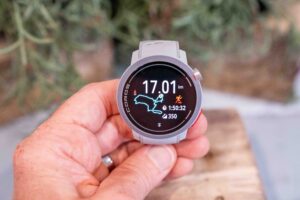
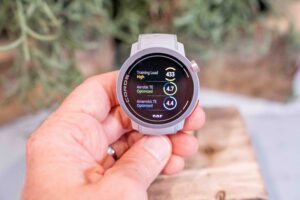
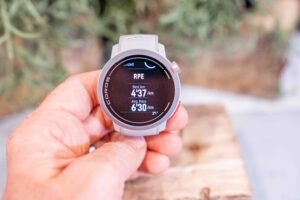
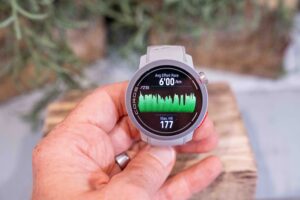
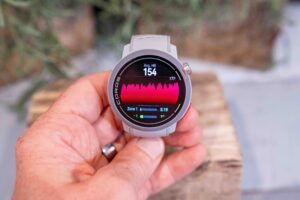

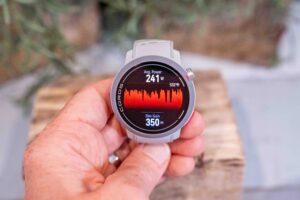

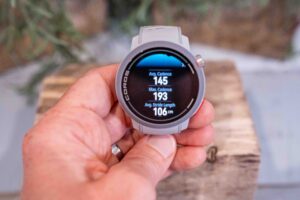
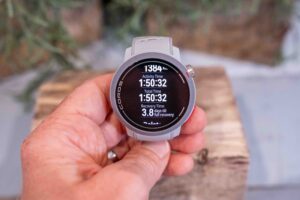
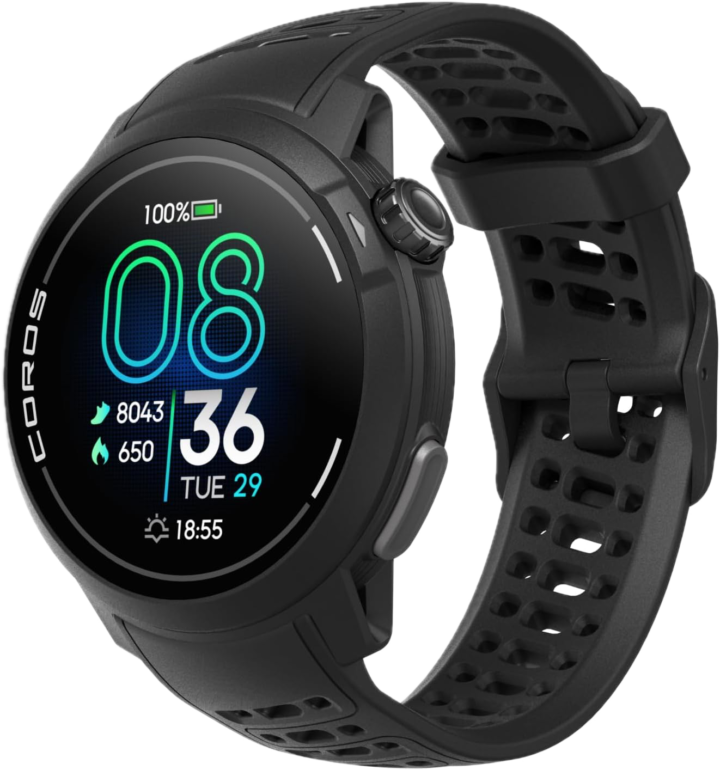
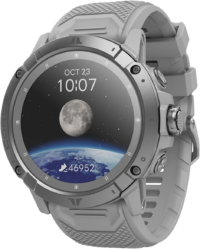
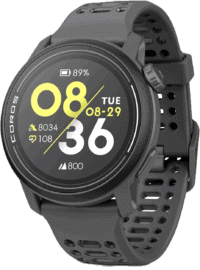

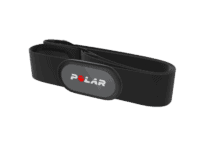
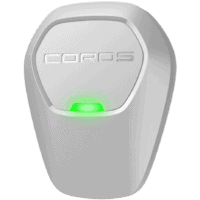
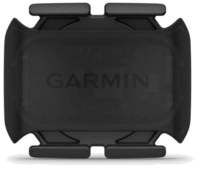

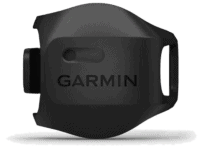

















Interesting to see them upping their AMOLED game, ty for the insights, as always, Ray.
Minor typo, I think: “leave a wetsuit on anything”
If you had a suit on, then, technically, it’d leave you with a wetsuit. ;)
Thanks!
What is a “scaarnbos”? i.e., “…slightly reduce GPS accuracy in certain scaarnbos,” 😉
Great stuff as always!
Scaarnbos is a trail GPS ‘scenario’ that’s gone deep into the Dutch bos….obviously. ;)
I gather Garmin 265 can have maps via CIQ
I bought my daughter a Coros Pace 3 watch for Cross Country. She also has Stryd Duos. One of the great things about Coros is that they have native support for foot pod power meters whereas Garmin does not. However, one of the most frustrating things is that Coros cannot import workouts from other platforms. It also does not have the ability for advanced running dynamics like balance, for instance. At this price point, you’re getting dangerously close to Garmin prices and lacking some pretty big training features that do not appear to have been added with this watch.
If you add the foot pod, the metrics go significantly up for data
Pretty sure you can import from Training Peaks (I was doing that for awhile) via the website. Yeah, just googled it (I haven’t taken my Pace 2 off the charger in over a year, so it could have changed….)
link to support.coros.com).
The whole “native support“ is a joke. What does it mean? It’s just showing Stryd as “Stryd“ – no syncing power zones, no workouts, nothing… On Garmin you can install CIQ app and everything works smoothly.
P.S. I’m writing this as ex-Coros user. I bought the watch only because of the Stryd support and I was very disappointed.
Same price, roughly same features, etc… which would you pick for a running watch and running training feedback – Suunto race s vs pace pro?
Two glasses of wine before bedtime is likely to decrease your HRV right?
Obviously depends on the person, but correct, it should decrease the value (e.g. from 50 to 40), or such. Re-wrote to be more clear. THanks!
“ While I’ve had a lot of interval workouts lately, none of them have been pain-inducing (I’ve been accompanying my wife on her workouts)” – Whoo, that’s a burn I didn’t see coming 🤣. I would have a hard time keeping up with your wife 😁
I haven’t seen any figures quoted for GPS battery performance for Always-on vs raise to wake, any insight on this?
All Systems On
(GPS, GLONASS, Galileo, Beidou, QZSS) 38 Hours
28 Hours (With Always-On Display)
Dual Frequency
(GPS, GLONASS, Galileo, Beidou, QZSS) 31 Hours
24 Hours (With Always-On Display)
Daily Use & Sleep Tracking 20 Days
6 Days (With Always-On Display)
Thank you!
They just forget three of the buttons… oh well. And that cycling track that was so horribly bad, wonder if that has any relation to the battery burn issue you reported as well with the GPS going crazy? (And maybe the fix, will fix that also… remains to be seen I suppose?)
It was the cycling Heart Rate that was horribly bad, not GPS.
Of course Amoled watches can rival MIP watches… as long as the display stays off. Otherwise battery life will always be mediocre compared with MIP, where display on is a given.
But I understand four days of battery life must sound like heaven to Apple loyalists ;-)
To be fair, 24 hours of Always-on display in the highest dual frequency mode is seriously competitive regardless of screen type, but yes for daily usage it’s not really a comparison
Yeah, as Matthias said, this is *beating* the battery life of the COROS Pace 3 in GPS mode (any mode you want).
Sure, it won’t beat it in smartwatch mode, but then again, at least you can see you screen in the dark now…
Well the Pace Pro is significantly larger and thicker. No miracles there, just a much larger battery than the Pace 2.
As for seen the screen in the dark, dunno. MIP has never been a problem for me. When I’m running, there’s a backlight. When I’m not running I’m OK with it being like any other watch: if there’s some ambient light it’s perfectly readable. If not I’m probably sleeping :)
The point is the battery life difference is very much still there. Amoled looks very pretty though, I’ll give it that.
On my apex 2 pro the stress is zeroed out during workout …
Cronos, Polar and Suunto now all have a very interesting watch in this price point, with maps and arguably all running features one needs. But as you mentioned, Garmin does not – the 265 is more expensive, no maps.
Do you have an idea if and when Garmin will come up with a competitive watch?
Or do you think Garmin will focus on the expensive realm of sportswatch/smartwatch/lifestyle watch realm?
In the UK the Garmin Epix 2 is £325.
You can add maps to the FR265 via their CIQ apps
The Epix 2 is not sold anymore in the Garmin website (the pro still is though) so I’m a bit reluctant here. Not sure how long it will be maintained with updates, Garmin does not have a strong track record here.
But you are right, the fact that these watches do get cheaper when they are on the market sometime, and much cheaper after a longer time, makes it that looking at ‘older’ models becomes interesting now the market becomes mature.
But I am actually wondering if Garmin will choose to continue battling in this price range, that’s the reason of my question.
Another great review. Very minor point, but at least on the Pace 3, you have the option to switch off stress measurement during workouts.
We far off the Oura review?
Another review praising a switch to AMOLED display while we can clearly see now that after 2,5 years Garmin Epix watches have a huge burn in issue when using AoD and no amount of pixel shifting and other tricks will change that. Not good in terms of sustainability and environmental awareness :/
There is no “huge burn in issue” with the Epix screens. Simply doesn’t exist.
There’s been a handful of people with burn-in issues that have been reported on Reddit/etc.., and in almost all those cases, they were using 3rd party watch face apps that for whatever reason weren’t adhering to guidelines. Beyond those few people, Garmin has replaced any defective units that showed burn-in (just like they replaced defective units of MIP based watches that had other issues).
If this was “huge” issues, we’d see it in every comment everywhere, given the millions of Epix units sold.
Again – from environmental perspective replacing units over and over isn’t a good thing. And this right here definitely looks like a stock Garmin watch face: link to forums.garmin.com
Let’s wait a couple of months and see. Why would people deny the volatile nature of AMOLED screens when we all know that they’re made of organic compounds which degrade with use, leading to gradual reduction in brightness and efficiency?
“they’re made of organic compounds”
Virtually everything is made of organic compounds. That doesn’t mean anything. The compounds in your MIP-based watch battery also degrade, regardless of whether or not you use them.
What matters is the designed lifespan for these units. After all, there’s plenty of people still using AMOLED-based Apple Watch Series 3/4/5/etc out there, 6 years later without any issue. And outside of Garmin’s learning curve with their first AMOLED watch (the Venu 1), we haven’t seen issues on subsequent watches from Garmin.
Nor have we seen widespread issues with Samsung watches, or, or, or…
If you don’t like AMOLED watches, that’s cool, but there’s no reason to fear monger saying something is a widespread issue when it’s not.
Ray, how do you know that Garmin has replaced all those faulty units? Do you know all people around the world with that issue? I am simple curious.
Be serious, you can not have such information as long you do not work for Garmin as mid-level manager in customer support dept.
How do I know?
A) Because most of the threads where people report the issue, eventually follow-up saying they contacted Garmin support and they swapped out the unit. Pretty straight forward.
B) I talk with the people at Garmin over those entire divisions about these sorts of issues when they arise. I don’t write about every single conversation I have, the vast majority of them are trying to help consumers sort out issues behind the scenes. These conversations are at every level up to the VP’s, and even sometimes the CEO at Garmin. I talk with the VP’s and above at most companies I review, including Google, Apple, GoPro, Wahoo, COROS, Suunto, Polar, etc…
So yes, I do actually know how these issues are resolved, if they make it to my radar and warrant me asking about it.
No wonder they convinced you it’s OK to replace a watch after 3 years of AOD usage ;) All I’m saying is it would be fair from an honest reviewer like you (and I really like and appreciate your reviews) to say “Hey, these AMOLED displays are great, colorful and all but don’t expect them to last as long as MIP displays cause the tech isn’t there yet. Maybe Micro LED will change that but for now it is what it is”. Maybe then people wouldn’t buy as much AMOLED units and Garmin wouldn’t kill off smaller MIP Fenix ;)
Personally I think increased battery wear as a consequence of AOD is going to bite much harder than Amoled burn-in. But hey, people might be OK with replacing their watches much earlier and for Garmin and co. surely is a nice side effect.
And reviewers also get more hits when those people have to look for a replacement. Good for business all around.
They do replace units when you have issues, their support in North America is fantastic, in other places, not so much.
I had an Epix Pro for just over a year, to be exact, 13 months, when I noticed burn in. I only used the STOCK watch faces in AOD most of the time since it was the 51mm. What made me get a replacement was a touch screen issue with ghost touches. So Garmin sent me a recertified Epix Pro 51… Altimeter is crazy. So I return that replacement and get another recertified Epix, this time, first time I turn it on there is a dying pixel that shows up every time the screen turns on…
So once again I return it to Garmin, and ask for a Fenix, which they obliged to. Now I’m back to MIP and happy with it, since my Fenix 6 lasted YEARS without issues unlike the 3 Epix Pro’s I tried.
Interesting. How do you know that they simple do not tell you the truth? Or trying make a good PR via well known YouTube influencer? I doubt that because as a ordinary customer my experiences with Garmin and Coros support are quite opposite (HR sensor/firmware malfunction in both cases: “not our fault, device is ok, good bye”).
Back to main topic: do you have specific number of units which were swapped due to that issue? Or at least percentage of units (swapped/change request). If they have such a good policy why not publish that information?
No company’s going to provide specific unit numbers publically. Ultimately, this just isn’t a super common issue. On my original Epix review, there were nearly 700 comments, of which, only two comments had some sort of burn-in issue. Garmin swapped out the first one, and the other person never replied back.
As we’ve seen in the past, if this was a real issue, plenty of people would have commented. Again, you’re trying to make an issue out of something that simply isn’t an issue with modern AMOLED displays and the associated software tweaks to mitigate it, such as pixel shifting, dimming changes, and more).
I had a Venu with bad burn in. Garmin gave me a discount on a Venu 2, but didn’t replace it for free. Guess it’s still fair since it was more than 3 years old.
“On my original Epix review….”
Ray, is your blog anyhow statistically representative to WHOLE population of Epix owners? If no, that numbers (2/700) means nothing. If you want tell anything about population base on sample you need that (see: link to en.wikipedia.org ). By the way, is 1 comment equal to 1 Epix owner?
I have no idea whether burn out of amoled screen is an issue or not. I do not care about it. I wonder if that kind of information which you provide can be trusted – that’s the real question.
PS could you publish raw heart rate data from your tests? Along with information how many runs/rides/swim sessions you performed?
“I have no idea whether burn out of amoled screen is an issue or not. I do not care about it.”
Then what on earth are you upset about? Figure it out, then come back. If you’re just trying to poke holes or stir the pot for the fun of it, then frankly, that’s the textbook definition of an internet troll.
“PS could you publish raw heart rate data from your tests?”
It’s linked to for every single set above, as it is on every review, for every device I review. I generally perform 1-2 workouts a day on the device, from when I receive a device (anywhere from 7-10 days before, up to a year before).
And yes, I’m happy to state that I find the comments section of my reviews a pretty good barometer for figuring out if things are good/bad/whatever about a unit. People often come here to post comments about problems they’re having, in hopes of getting attention for that problem. 15 years worth of product reviews has pretty clearly shown that.
But again, I don’t think you’re interested in any of that. And every single post on this site you’ve ever made has made that clear, you’re just here to stir the pot.
“Then what on earth are you upset about?”
I am not upset, not at all:) All I want to know is where your knowledge comes from and take a closer look at your data (since you have a tons of it). Is it a problem for you?
“…I find the comments section of my reviews a pretty good barometer for figuring out if things …”
I told you that your blog readers (your sample) might not be a representative group of Garmin/other brand customers. You said 2 out of 700 comments got problem with that amoled screen, so this is around 0,3%. In real population of all Epix users it might be the same percentage or quite different – say 3-5%. You do not know that. Nobody knows that (beside Garmin;).
It is a statistical problem and it is called “self-selection bias”.
Agreed, Ray. I’m loving my Epix Pro Gen 2 and using the Mashake watch face without any issues.
This is just really teasing the Oura Ring v4 review. Can’t wait.
It’s funny, in using it daily, you kinda forget it’s any different than the previous one. Aside from having to charge it slightly less often, everything is sorta same-same. :-/
And unfortunately, for whatever reason, Oura isn’t pushing HR data right now on my workouts to Strava (GPS activities recorded via Oura app show up, from Oura on Strava, but void of any HR data, bizarrely). Seen some other posts on Reddit on this. Thus, looking at workout data accuracy is impossible.
These are the same issues I have since I use my Gen4 for a week now! And my Oura gets crazy hot when the green LEDs light up fully! I think I send it back and go on with my Gen3…
The optical heart rate sensor is good for stress/HRV measuring at rest, but during training is always recommended a heartrate-strap.
With heartrate-strap could be measured also during training the HRV and so the exact respiration rate calculated.
(HRV in milliseconds is different on inhalation/exhalation)
So I have after training my average respiration rate on my FR255 music and on the garmin connect web site.
With optical heart rate sensor only at rest is possible the respiration rate measuring.
Not many wearables has this feature, to measure the respiration rate during training.
I dont know if Polar or Coros has.
Even my Edge 530 cycling computer has the data field with the current respiration rate. On a long hill I try not go above 37-38/min
Regarding auto course syncing from Strava etc into Garmin – a correction there are despite the memory size the course limit is 100. After that you get a warning that no more course syncs are possible
…actually, you annoyingly don’t get a warning at all, it just silently fails on most Garmin devices. ;) A few will ‘not transferred’, but not tell you why.
That said, cleaning courses is easy enough, and ultimately that quirk aside – it syncs just fine. Why on earth Garmin can’t auto-clean (or have more than 100 courses) is beyond me. But so is why COROS can’t auto-sync….
Yes its a bit odd! I get loads of course ideas from Strava and regularly hit the 100 limit warning on my Epix Pro. Sunnto Race has a limit of 20 on the watch. But these are tiny files and dont need a hardwired limit.
Ps: The photo I posted was supposed to be my Avatar but appeared inline for some reason!
I didn’t say it’s widespread, I simply said it’s huge as the picture shows. And those mentioned Apple/Samsung watches probably weren’t used in AoD mode while I know two Fenix 3 owners still rocking their MIP based units without screen issues. My problem is that these watches are advertised as rugged and long lasting and I wouldn’t call them them like that if AoD forces Garmin to replace them after 2-3 years. If that’s not the case, I’ll take it back but it seems to me that they will start popping up more often.
Why are most watches so ugly?
Some are even more plastic than others.
The next one is even bigger and bulkier than the other.
In my opinion, the Polar Pacer Pro is pretty much the exception to the rule.
It’s a sports watch, meant to wear during sports, I’d say.
Sports watches designed to have the esthetics to wear all day do exist. They are much more expensive and have also most of the smart watch features. So yeah, they do exist. If you want to see some, look for the sports watches over €800,- .
I think that philosophy is fine for £200 watches. But when it comes to £400+ watches like the Garmin 265/965 I’m much less inclined to tolerate their ugliness. But I get that likely they either want you to buy an overpriced as f*ck Fenix or spend the same amount in both a sports and a “lifestyle” watch.
You‘re right! The watch is really cheap looking. I also prefer Polar watches. But honestly Polar lacks a lot of training metrics today. They have to improve if they still want to play an important role in the fitness watch market.
In theme sleep analysis 80-85% accuracy is an excellent metric.
(coros has a terrible sleep accuracy, garmin better, apple the best)
“The trend is your friend”
Imagine as comparison the Garmin Index S2 scale.
That calculates your body composition (fat, water, bone) far from a 100% accuracy.
But accurate enough, to see an excellent trend what happens in your body and how impacts training/stress your body composition.
So the sleep metric accuracy is not to compare to heart rate accuracy.
Serious manufacturer deliver an acceptable sleep accuracy.
Other manufacturer know, that this is difficult to check and they produce “something”.
The problem with sleep stage testing though, is that when a sleep stage is ‘wrong’, it’s entirely different. Thus, deep because light, or vice versa. Thus, an entirely different category (and meaning).
Hi Ray,
Will we eventually be able to print the ecg data like it’s possible to with Garmin?
My device just turned up and can’t seem to change the colour settings on the watch face which is a bit disappointing. I could on the Pace 3.
Seems pretty much the same just trying to figure it out.
Keep up the good work.
Jamie
Anyone else have issues with an iPhone 16 receiving text message always?
The Pace Pro is giving me notifications for whatsapp and Ring door bell but text don’t seem to be coming through. Everything seems to be set up correctly.
Awesome review as always, Many thanks
Wondering if Garmin Epix Gen2 (base version) at same price (in going deal brings it to £300) would be better option than Pace pro ? I am going to start my ultra marathon training and also want to have a stylish watch so that I can use it for daily usage.
What would you recommend?
We talked a bit about this exact question in the FIT File Podcast that went live yesterday: (link to youtube.com).
Ultimately, anytime the Epix Gen 2 is at $399USD/~£300 (especially Sapphire edition, but frankly the non-dual-freq GPS is so good in that chipset that it competes just perfectly fine), it’s going to be very challenging for not just COROS/Polar/Suunto to compete, but for Garmin’s own watches to compete.
We saw Epix Gen 2 Sapphite-Titanium down at $399 a few weeks ago for Black Friday, and it’ll undoubtedly be there again for Black Friday.
Obviously, in features, Garmin easily wins here. Not even COROS or Polar would try and argue otherwise. And materials, Garmin wins too. About the only area Garmin loses is the GPS battery life (I found smartwatch battery life actually about the same). The Epix Gen 2 gesture-based GPS battery life for All Systems is 34hrs versus 38hrs for the Pace Pro. Thus, on paper, COROS wins there, but practically speaking my results showed it closer to a wash in real-life. Accuracy of both is also probably a wash in real-life, albeit probably a slight HR edge to Garmin for outdoor cycling (but everything else in my testing showed a wash).
Of course, the ‘big’ question is what size of watch you want. Ultiamtely, the Epix Gen 2 is a bigger/heavier watch than the COROS Pace Pro. Obviously, it’s made of nicer materials and I think most would say it looks fancier than the Pace Pro. But at the end of the day if you don’t want a bigger watch, then it doesn’t matter about everything else.
Ciao, scusa la domanda io pratico ciclismo e ogni tanto palestra, per ciclismo ho un ciclo computer bryton con relativa fascia, ma vorrei un orologio per ciclismo cosa mi consigli senza svenarsi
The user interface looks nice. I wish Polar would copy some of these views, eg the data fields with different sizes. And Polar must improve on tranings metrics, like running readyness etc. Polar was such a leading company, and now they are way behind the others. But as this is not a Polar review: Thanks Ray for showing us the Chronos watch! The software seems nice, but the watch itself looks cheep to me. Polar‘s M3 (same price) or V3 (more expansive, but I got mine for 438€) are much nicer in my view.
I would love to hear your wife’s thoughts on size. I am looking to replace a pace 2 that I wear 24/7 but concerned about the size of this for a smaller female wrist.
Next time you’re chilling with the Coros folks, can you please ask them to add snowshoeing as an option?
As a die-hard skier from 2-years old, I’m afraid I can’t honor this request. ;)
Just kidding, I’ll mention it next time I chat.
Is it possible to use third party maps, such as trailforks or komoot maps?
HI. Does the Pace Pro have the equivalent of Climb Pro on my Garmin Fenix 6X Pro? Always liked it for seeing what is coming up on my runs?
Unfortunately COROS doesn’t have anything like that at this point. They’ve started that a bit on their cycling units (COROS Dura), but nothing yet for their watches.
Seems like Coros removed the ability to download maps over Bluetooth? Happy new owner of a Pace Pro but seems like I must be connected to WiFi to sync maps via the iPhone app
Hi Ray,
Do you offer Watch recommendations for specific activities? I see a lot of advice for runners, but not much for hikers. I’m a backpacker and looking at the Pace Pro, Apex Pro, and Fenix 7s Pro Solar. I care about gps/navigation and battery life. Anything else is a bonus. If you don’t mind giving recommendations, which watch would you suggest for multi-day backpacking trips?
In terms of hiking, that’s probably the activity that shows just how far Garmin is ahead of COROS/others. Namely, because of all the navigation features, both in terms of routable mapping (which others don’t have, they have basically a map underlay), as well as navigation features like ClimbPro, re-routing, etc…
Whereas for most running (sans-navigation), the differences are relatively minor. Put in context, a Fenix 5 Plus (from 2018) still has far more mapping/navigation features than a COROS Vertix 2 does. Whereas from a pure running standpoint, it’s far less noticeable. That said, the accuracy of a newer watch with multiband (from either COROS or Garmin) would be far better than that Fenix 5 Plus from 2018.
In terms of the Fenix 7S Pro Solar, if budget is tight, also consider the Fenix 7S Solar (non-Pro). Software-wise, it’s identical, save the ECG sensor and flashlight on the Fenix 7S Pro.
Cheers!
Thank you so much for your time and expertise.
I found several used Fenix 7S Pro Solar watches for $400-$450 now that the 8 has been out for a few months. That the only reason I was looking at the pro. Budget isn’t too much of a factor, but I would need convincing to spend $700 more for a new 8 than a used 7.
Any update on the GPS firmware fix for accuracy? Is the bug only for pace pro or does it also affect other coros watches? Thanks
I am thinking of moving from my Garmin Epix 2 to Pace Pro. The Epix 2 itself is a brilliant watch but the problem I have is Garmin’s software is SO buggy that I am just sick of an update happening and then something going wrong. I need to go back and work out how to install an older firmware I guess and then turn off auto-updates. But I shouldn’t have to deny myself new functionality just because it is rolled out badly. So am considering a switch
A few questions
1. Is COROS software buggy like Garmin’s? Do people find that a software update is released and then HR data or sleep tracking or something breaks?
2. This review of the pacepro says the training load in Coros was double that of all other platforms. Do people find this consistently or has it been fixed in a software update?
3. I have all my existing routes saved in ridewithgps.com How easy is it to import those into the pacepro? (I don’t have strava premium and dislike the komoot interface).